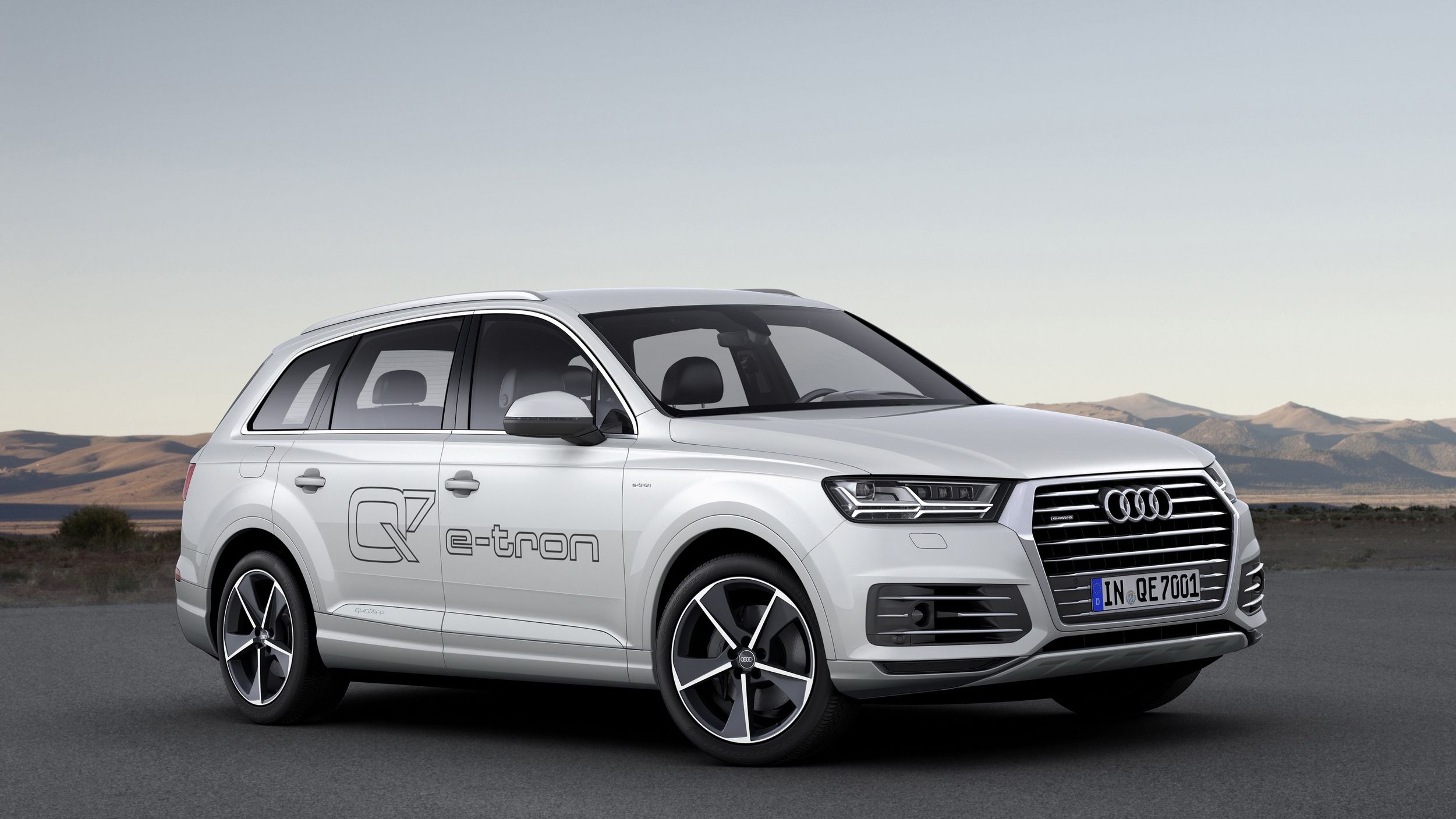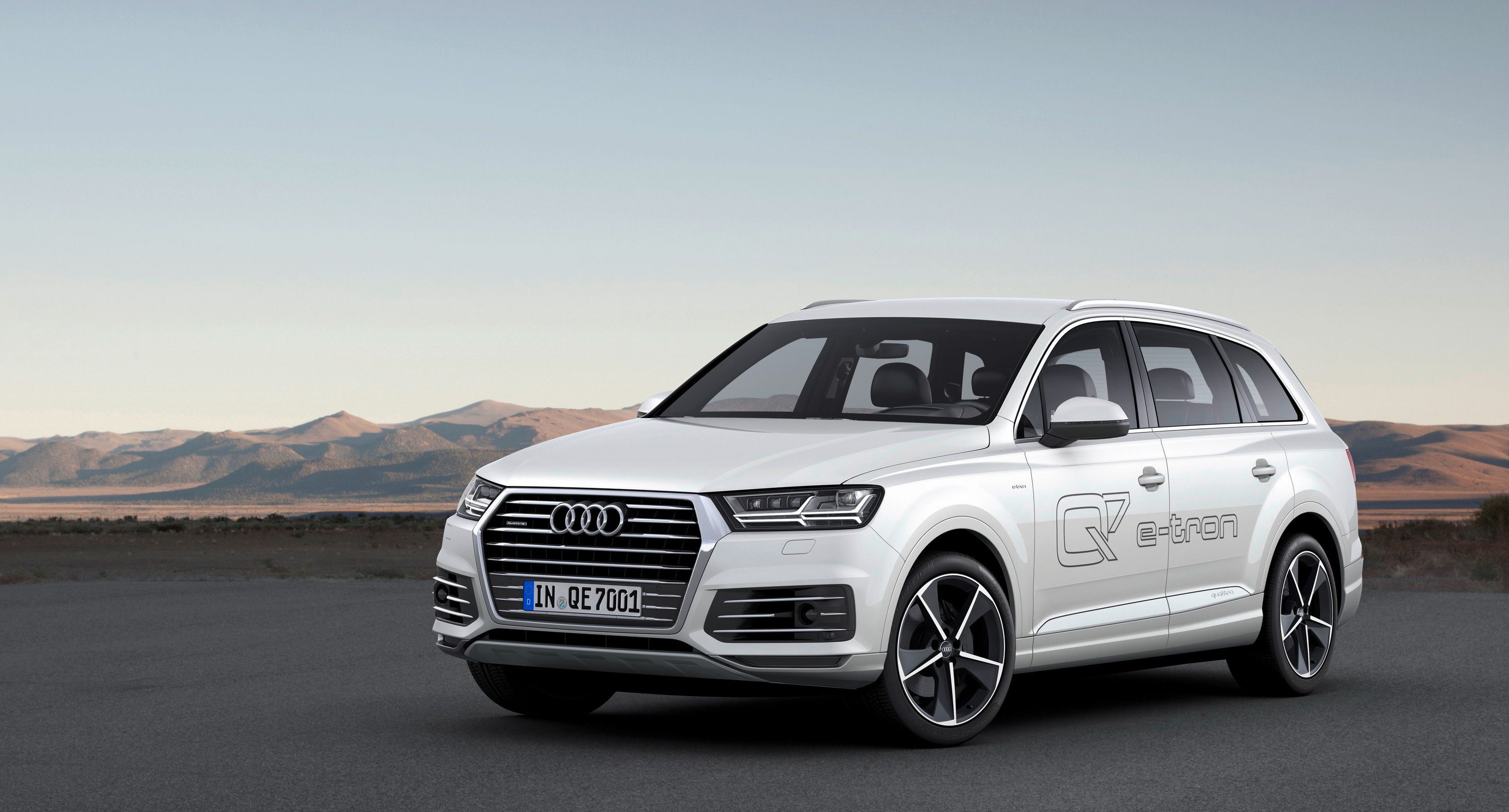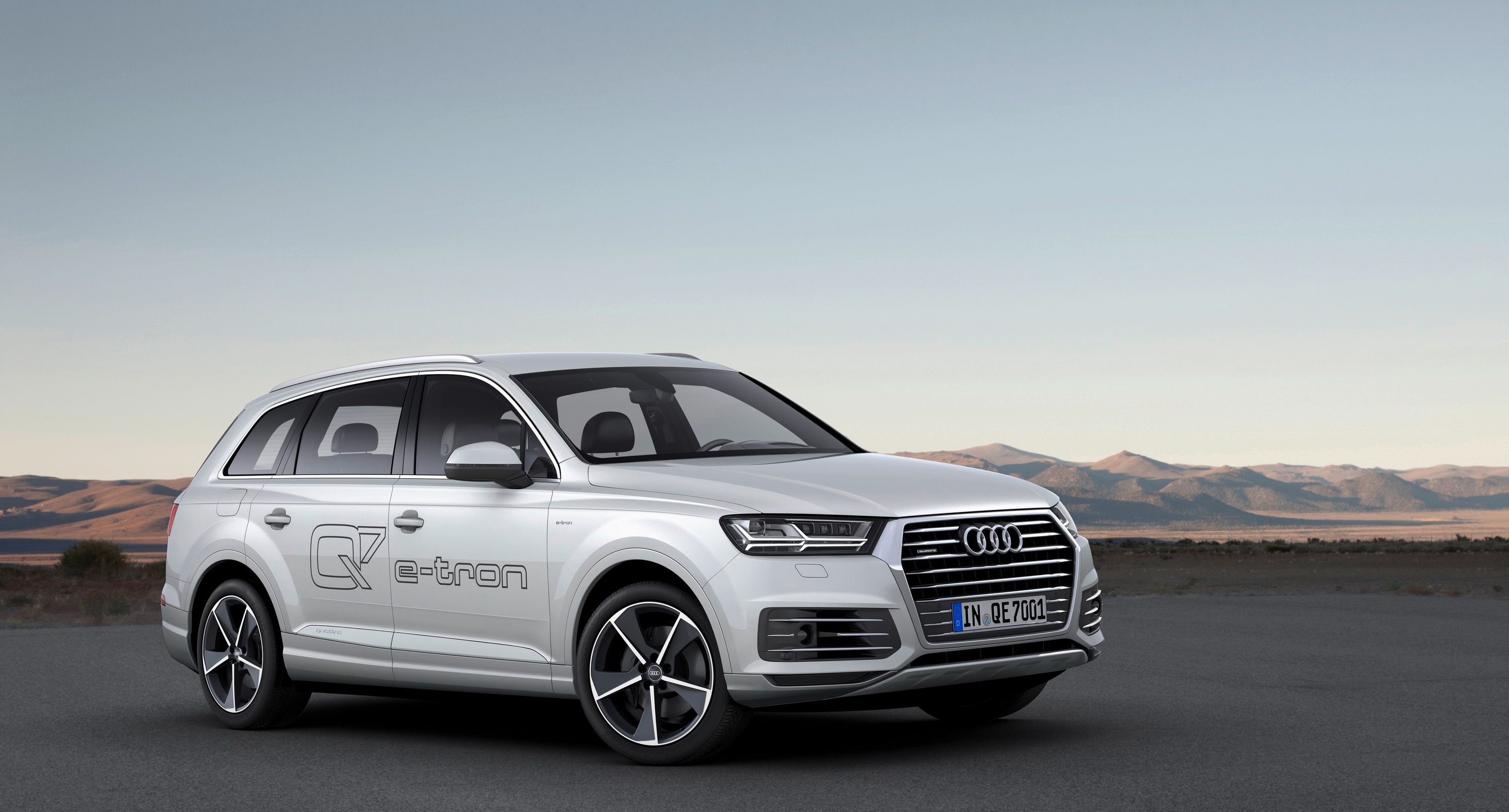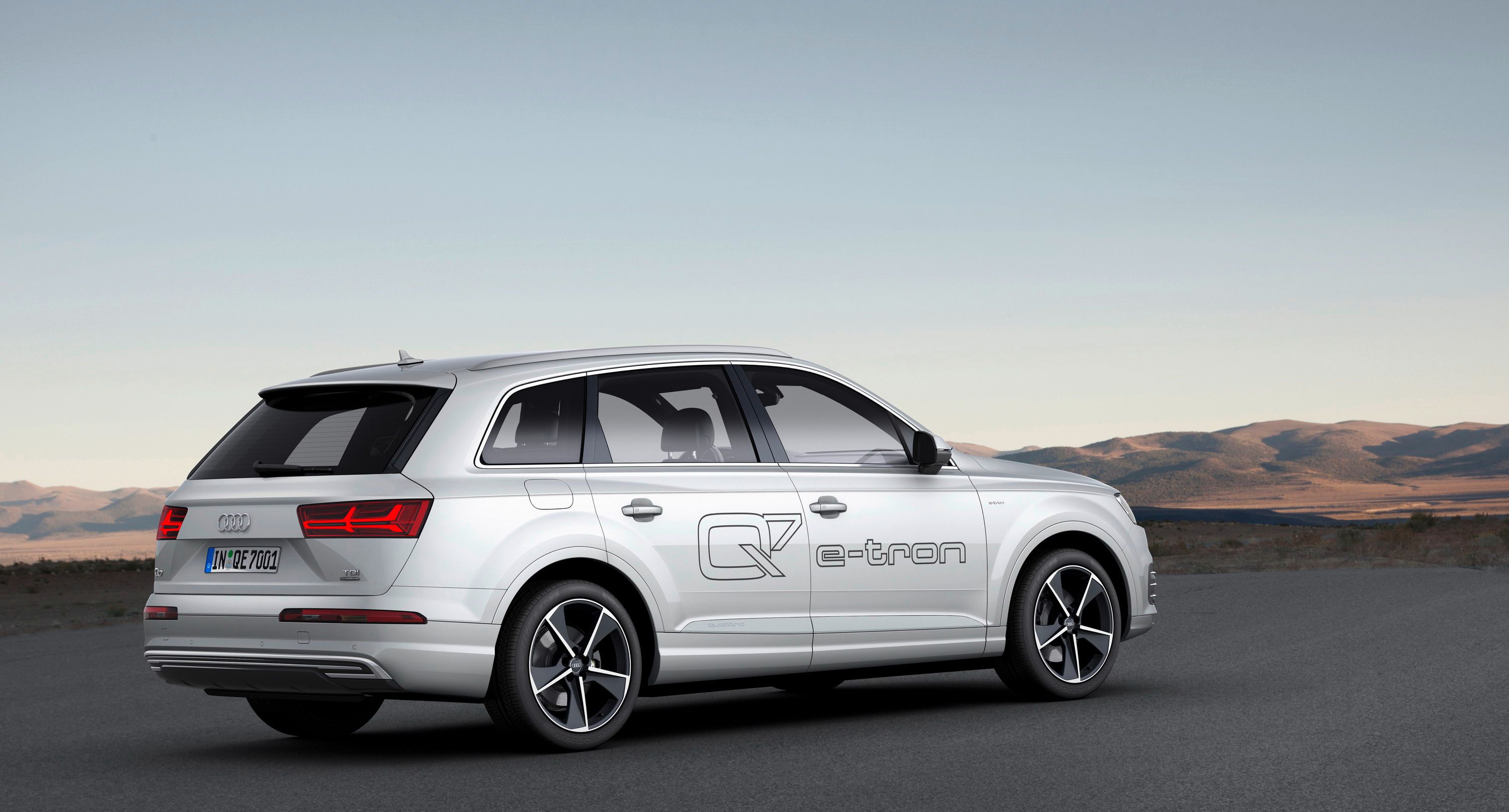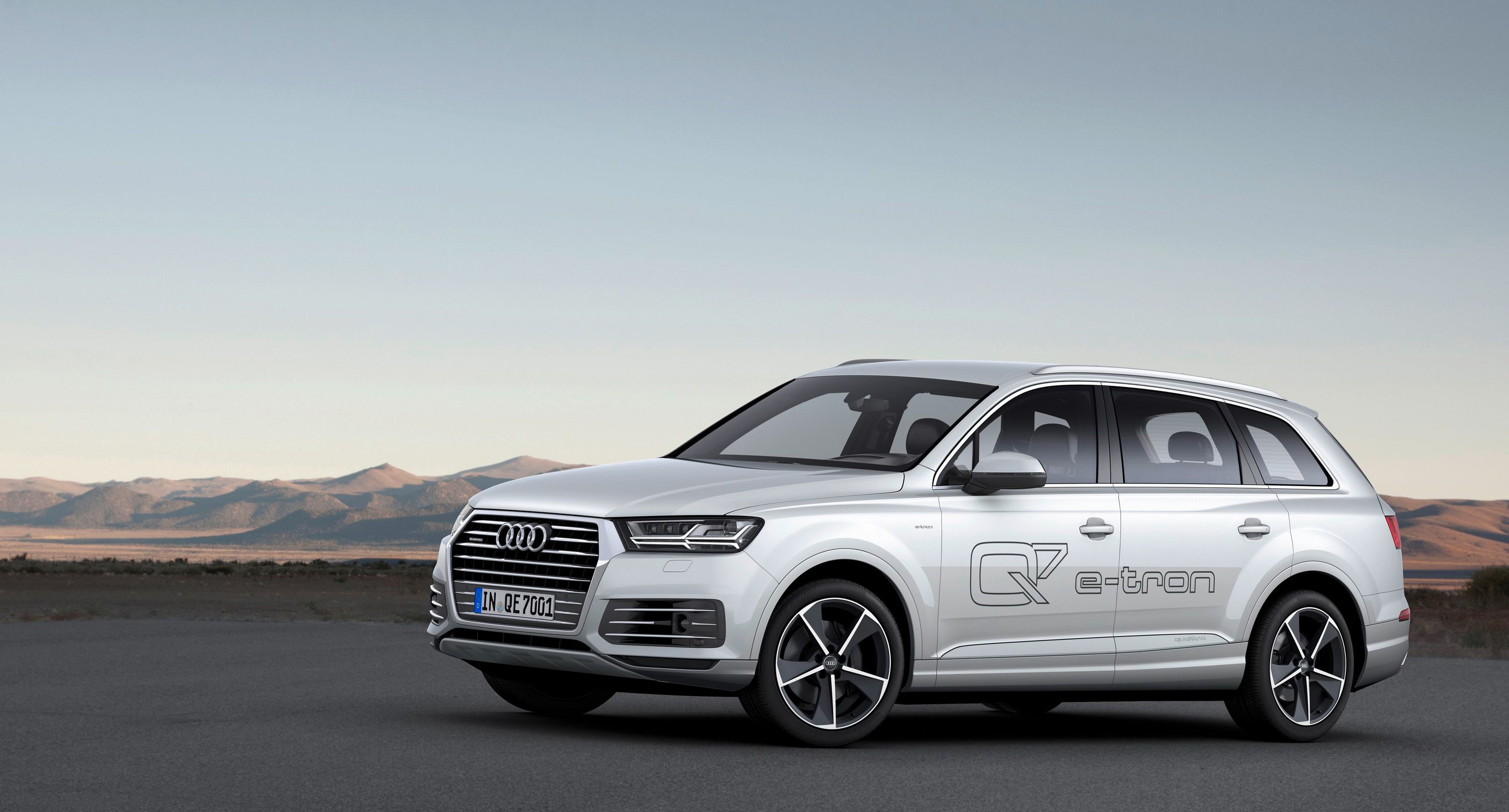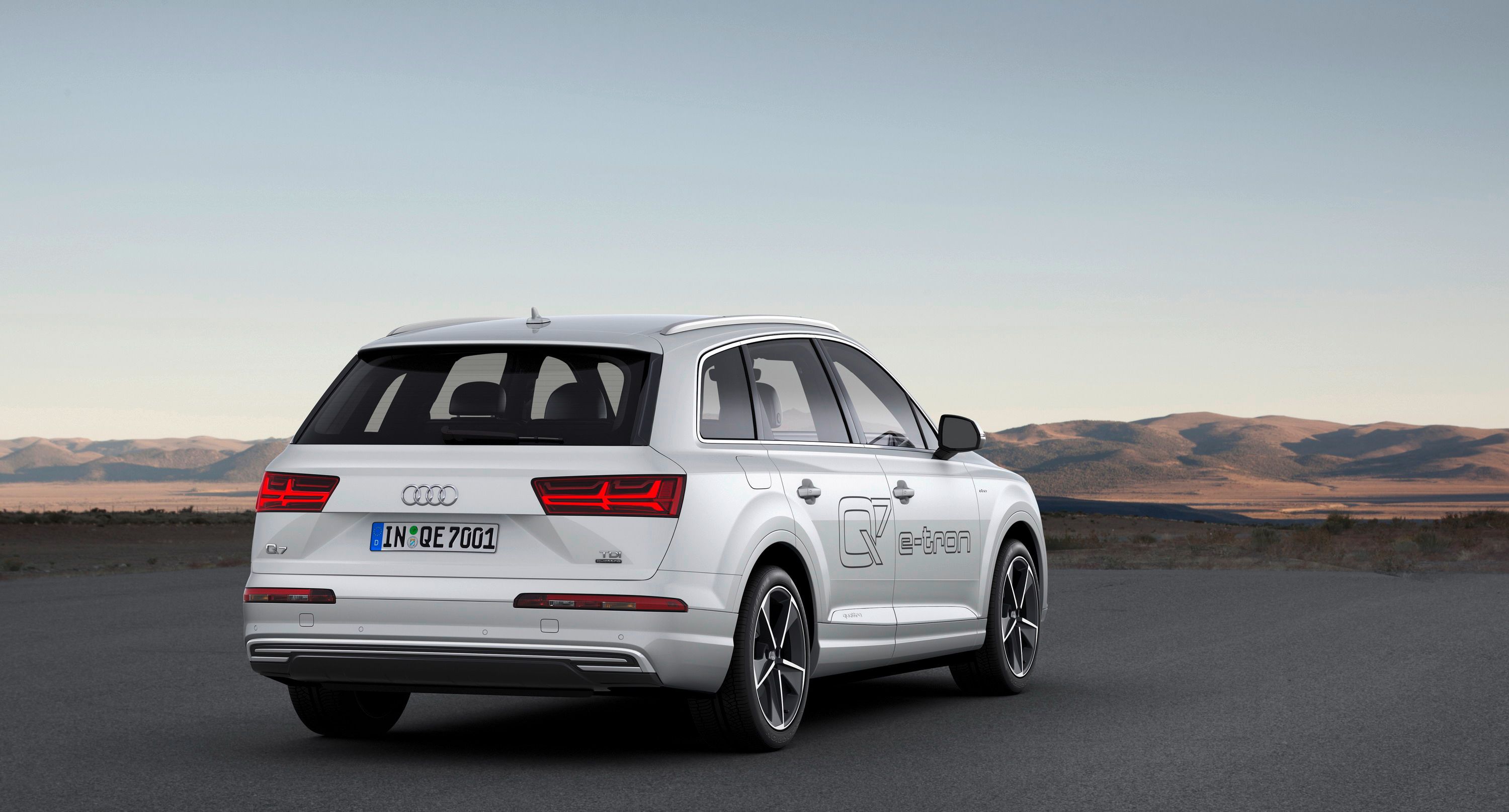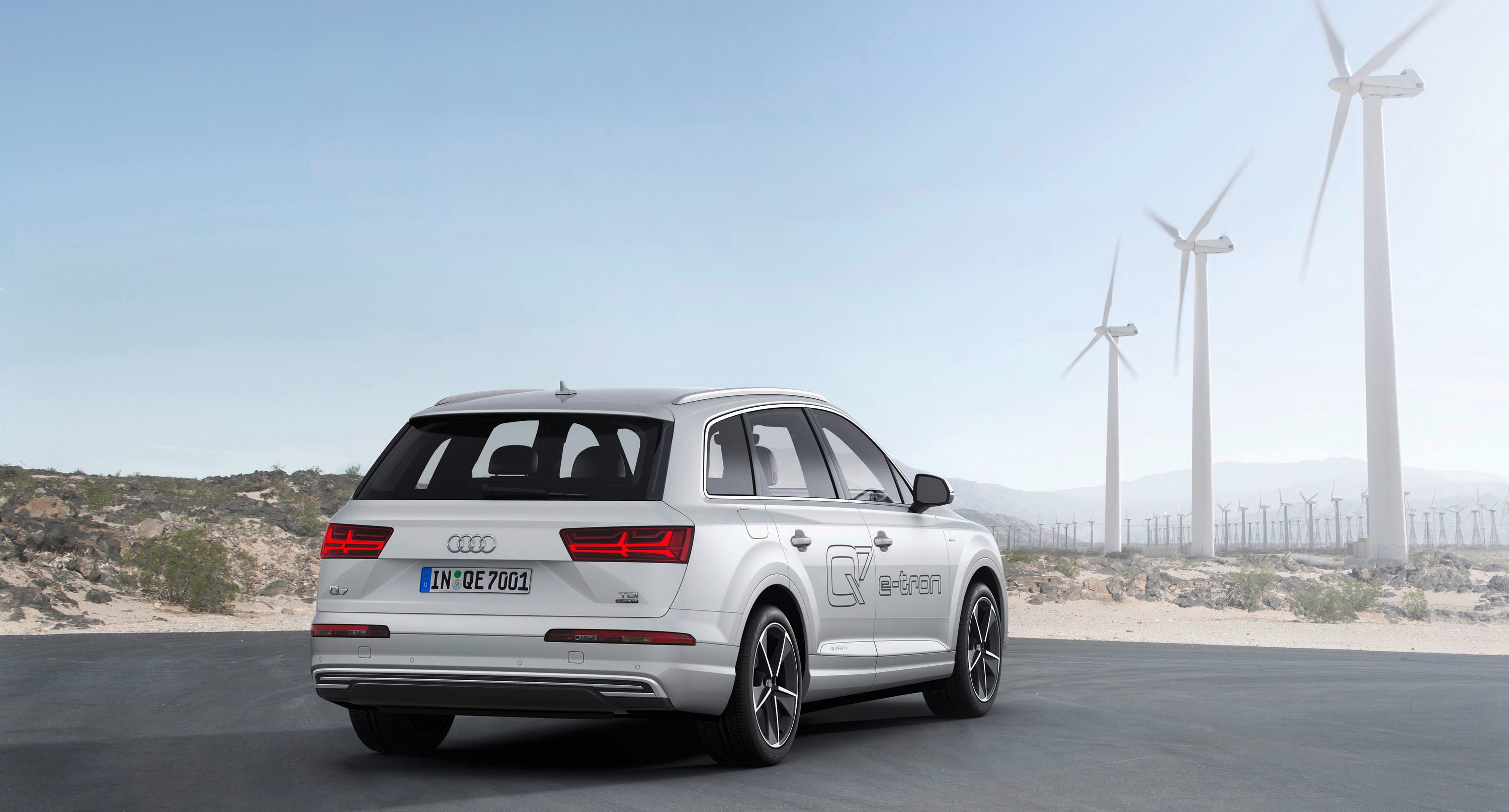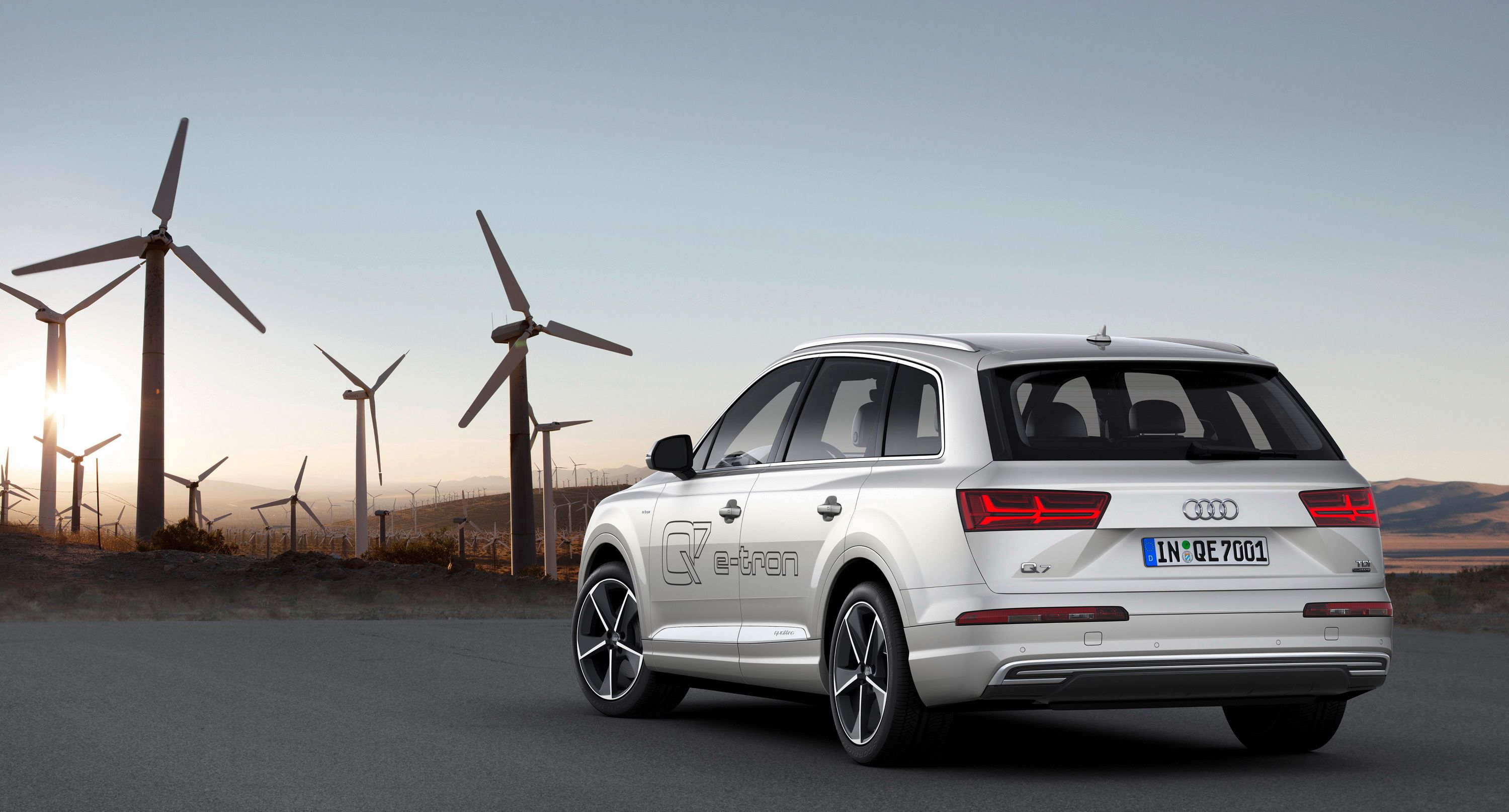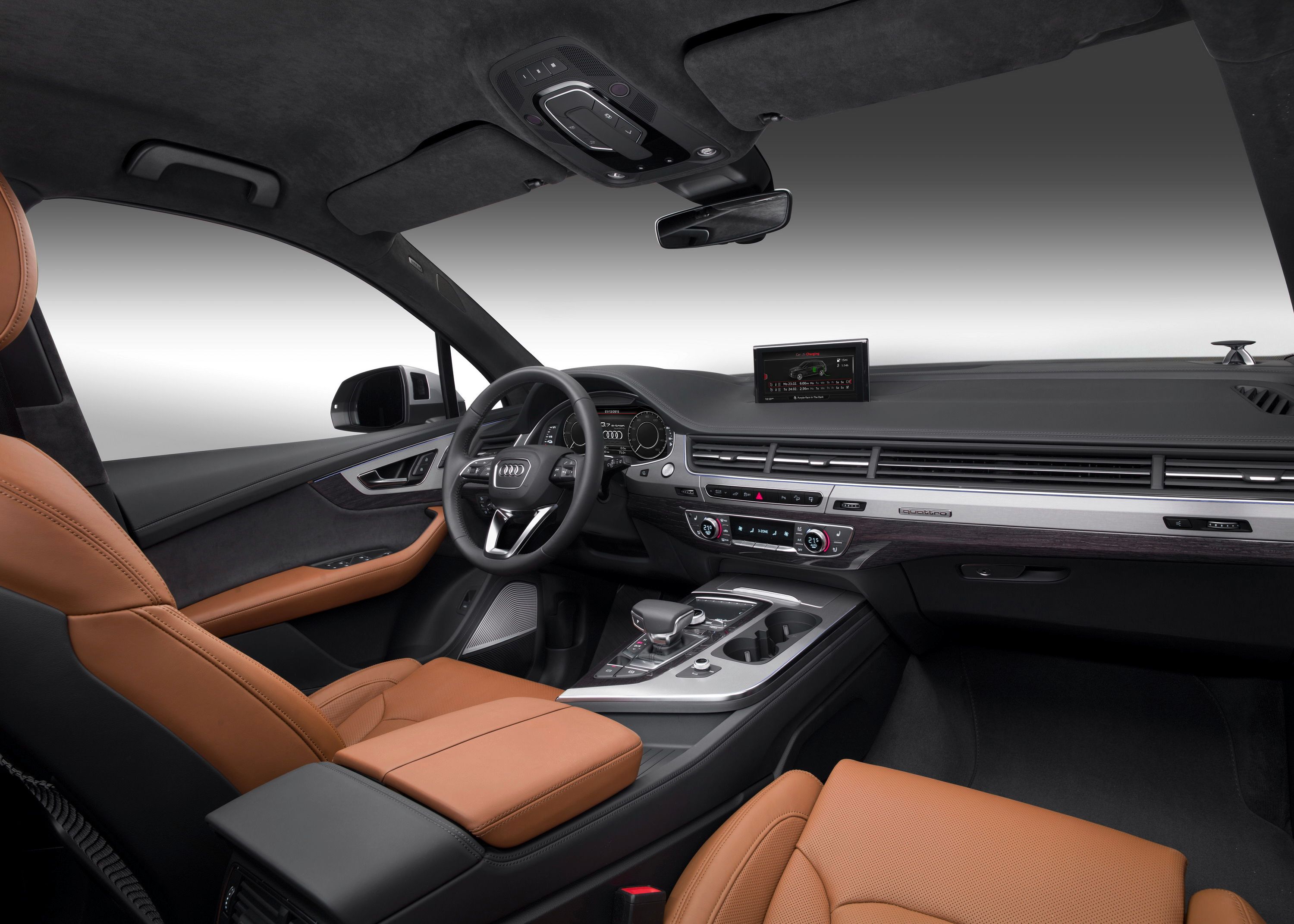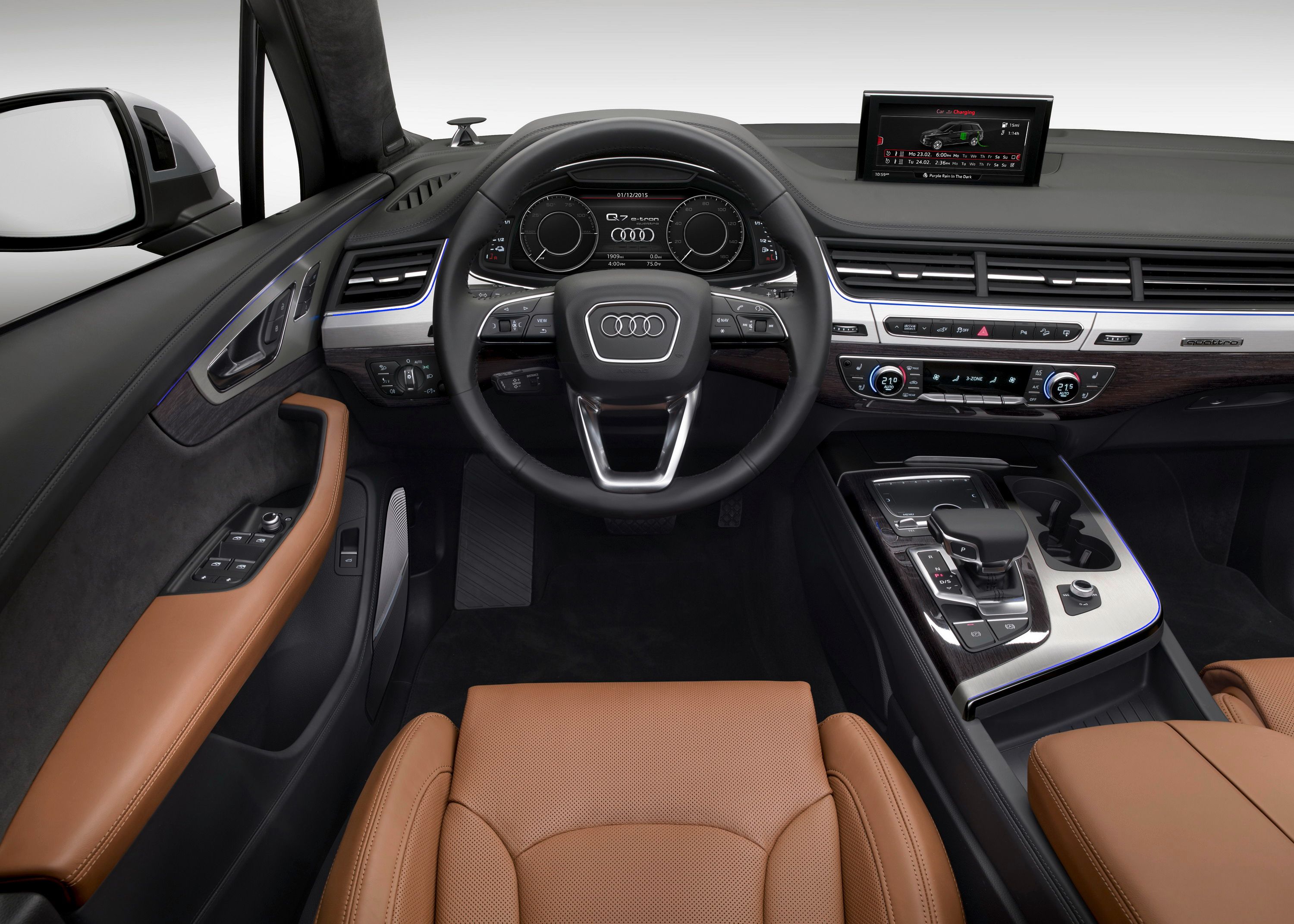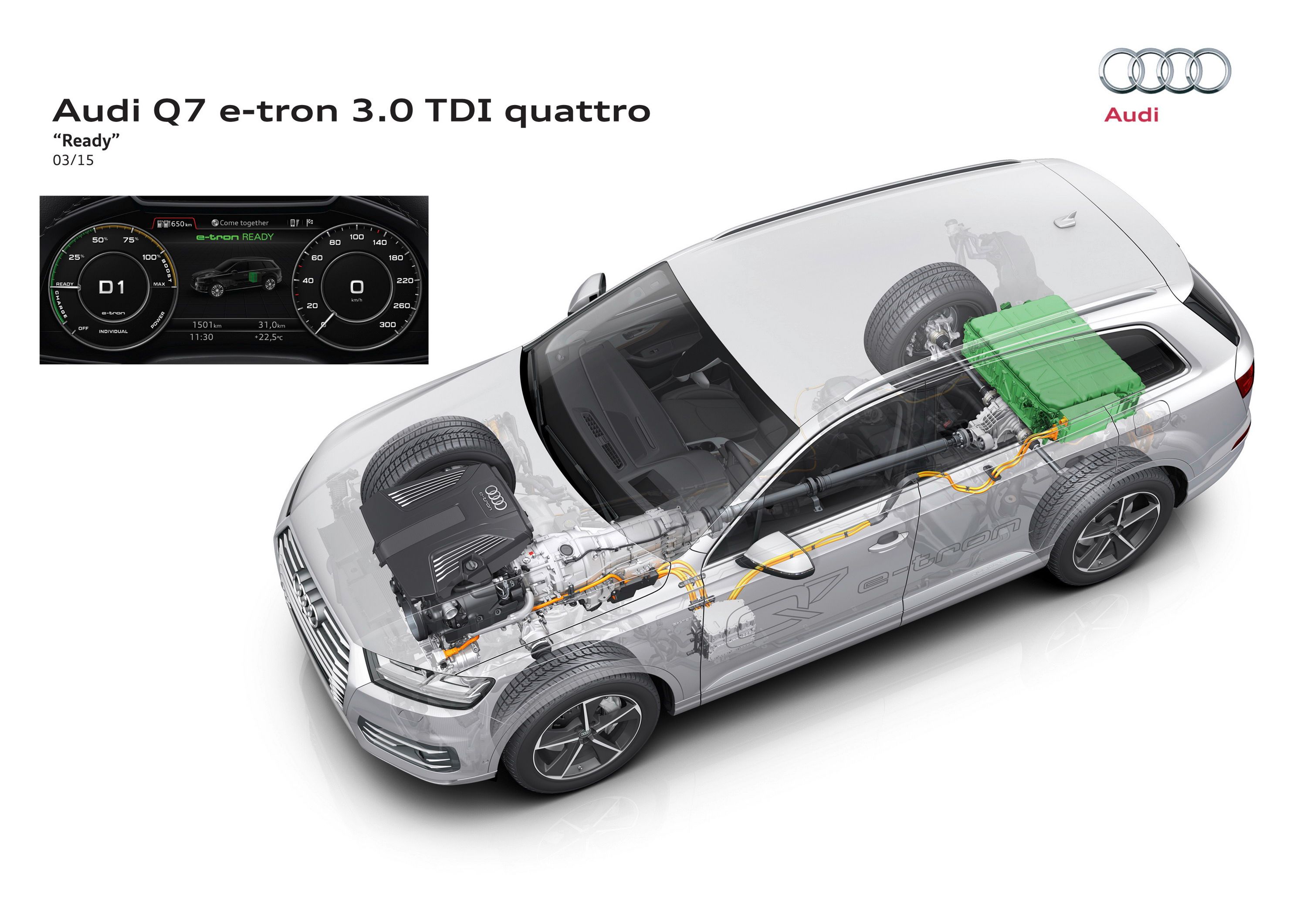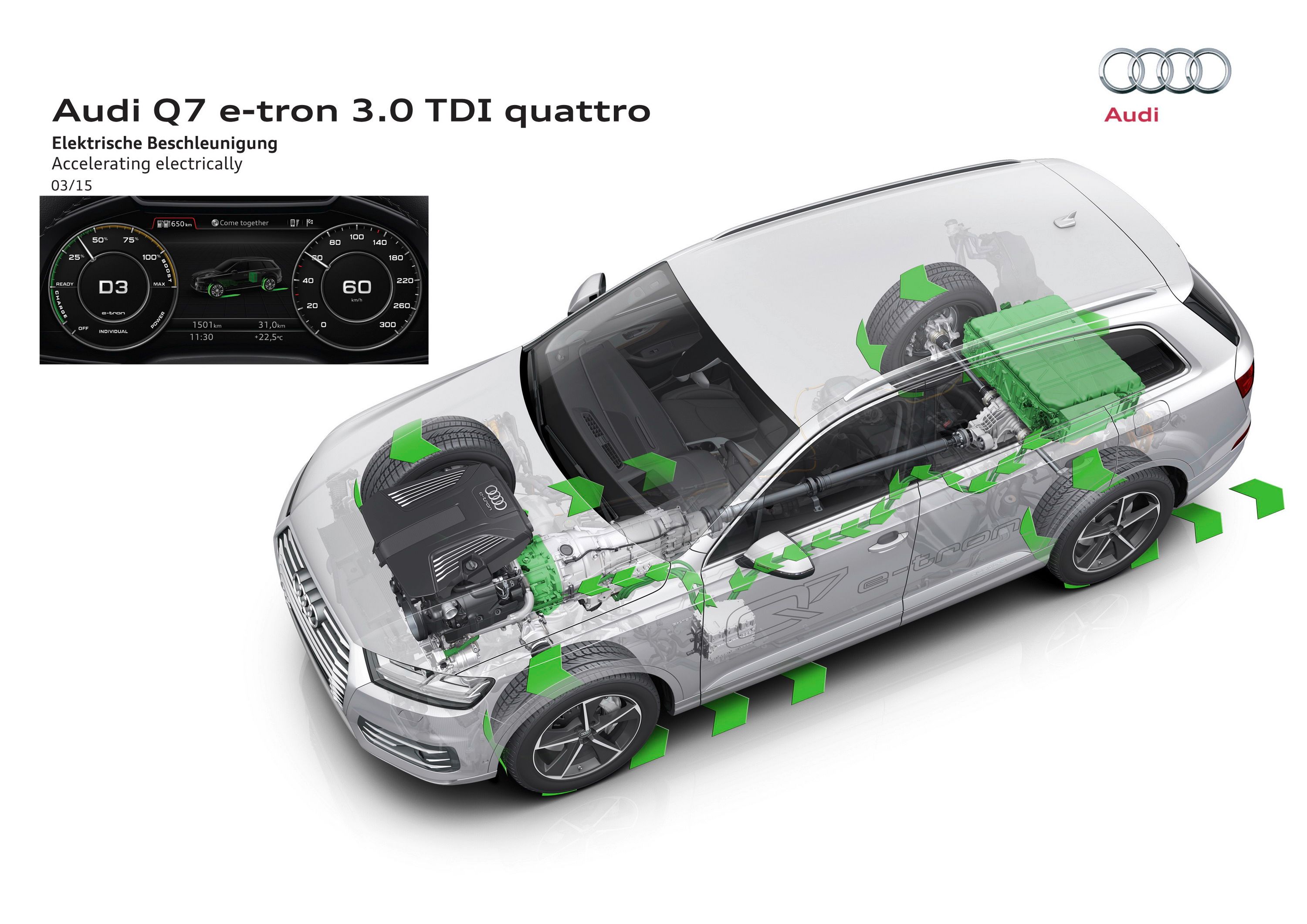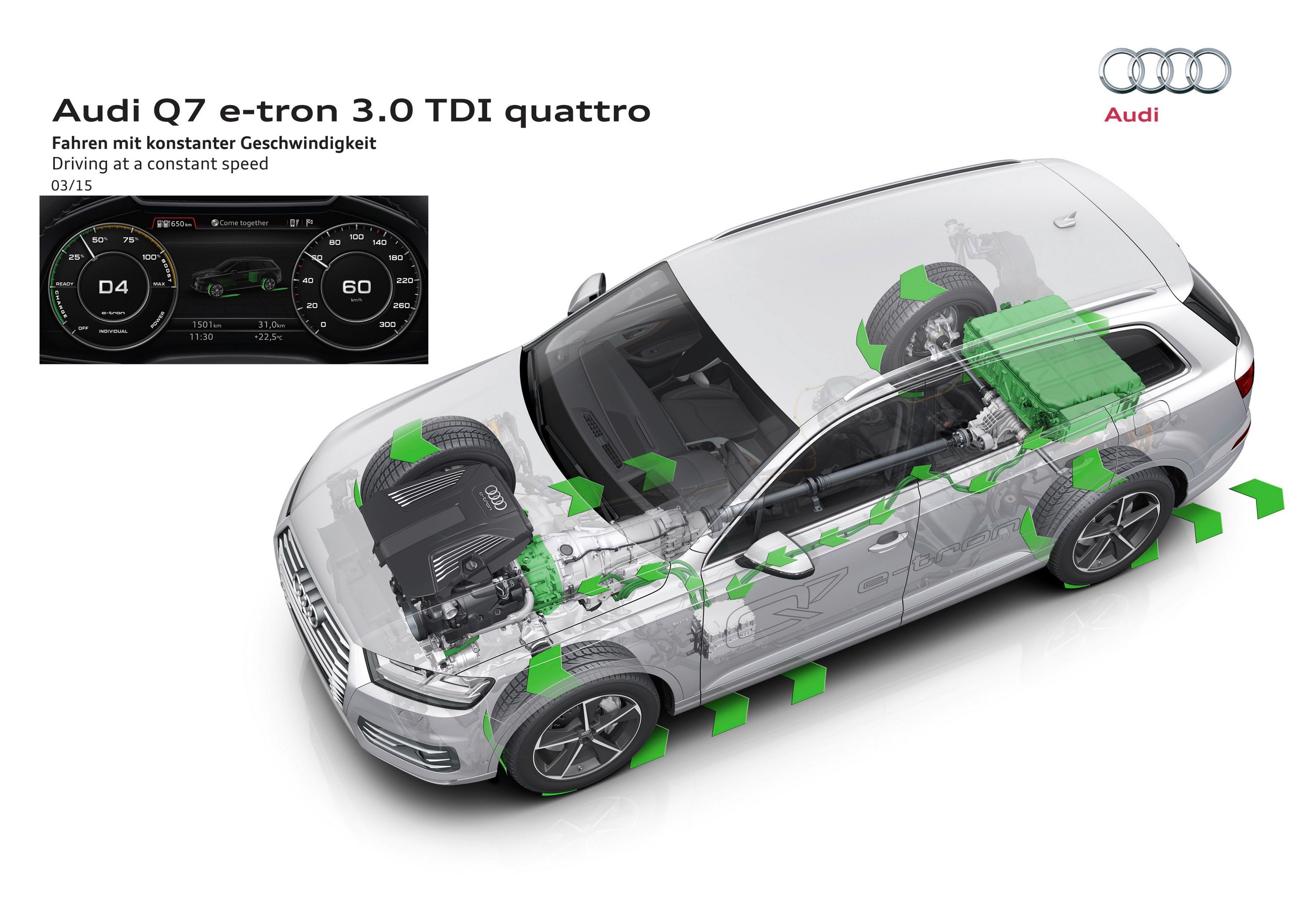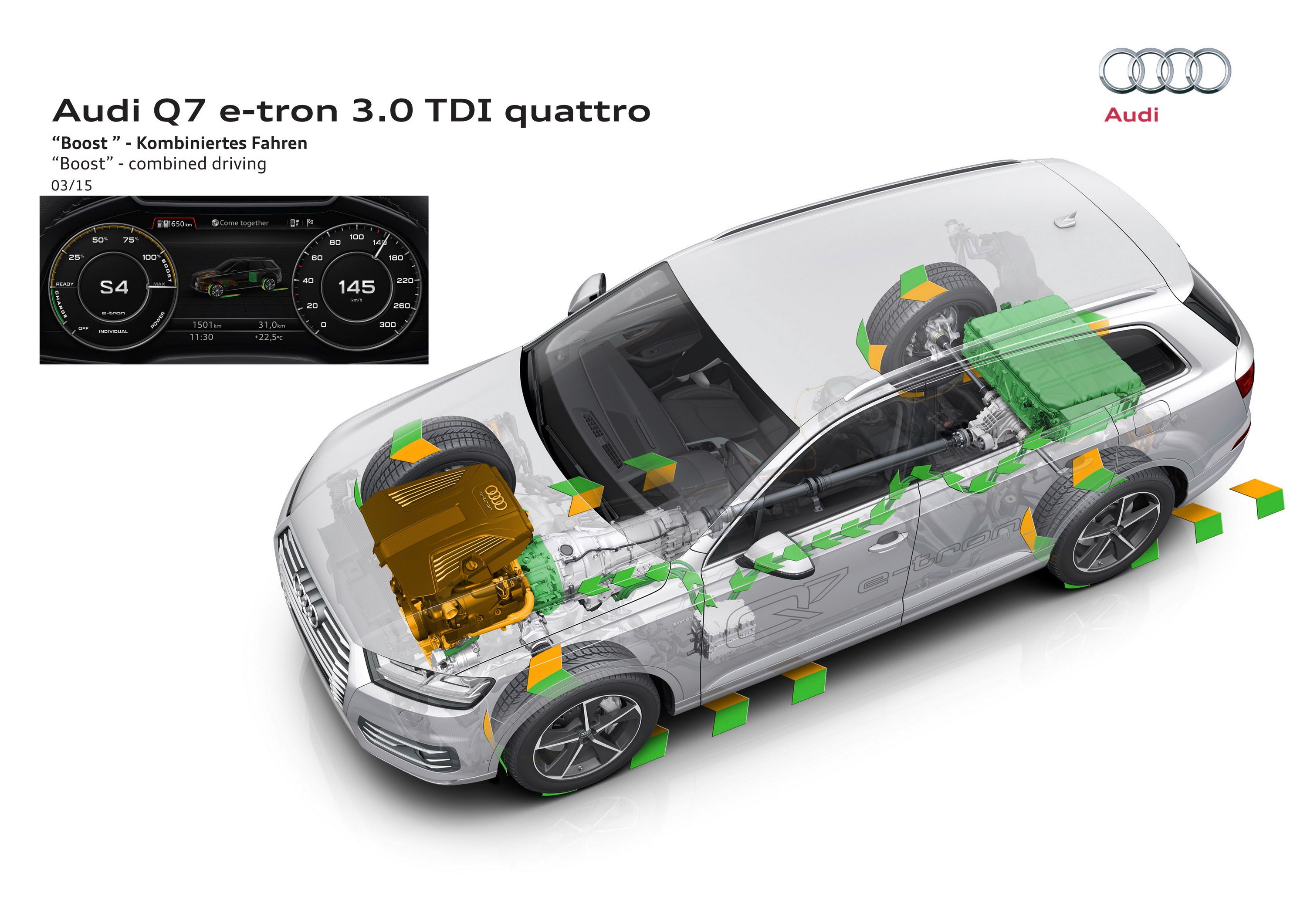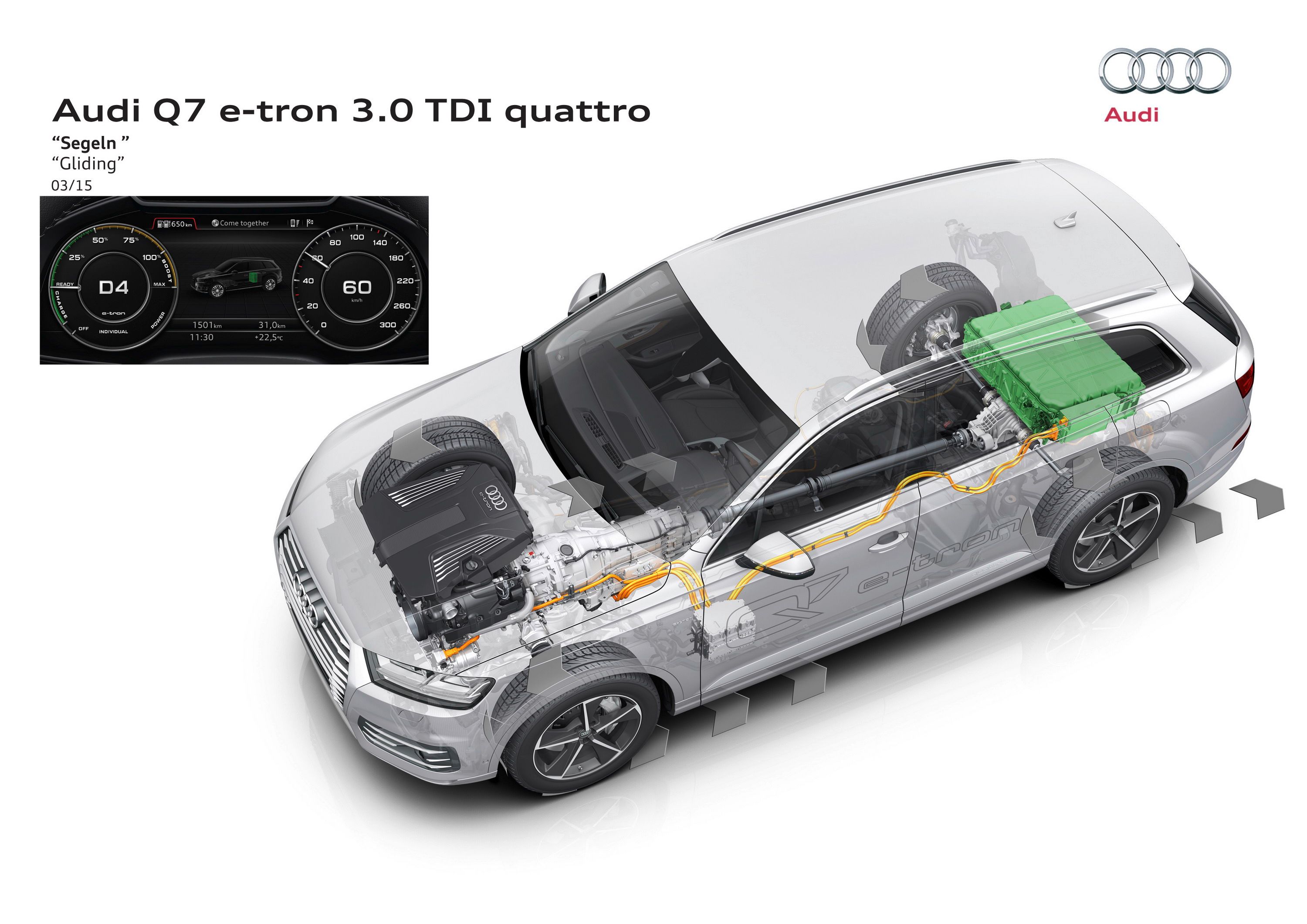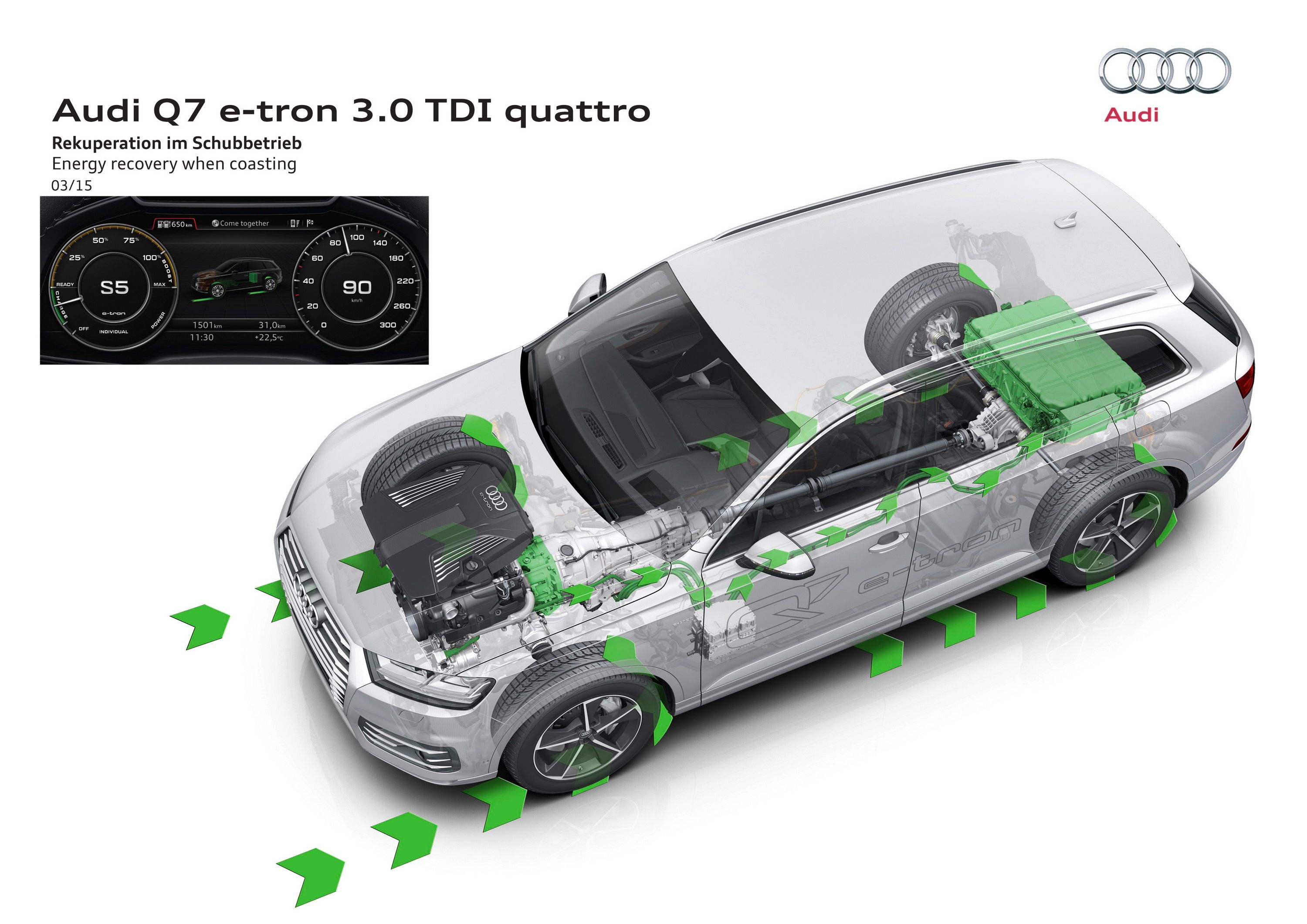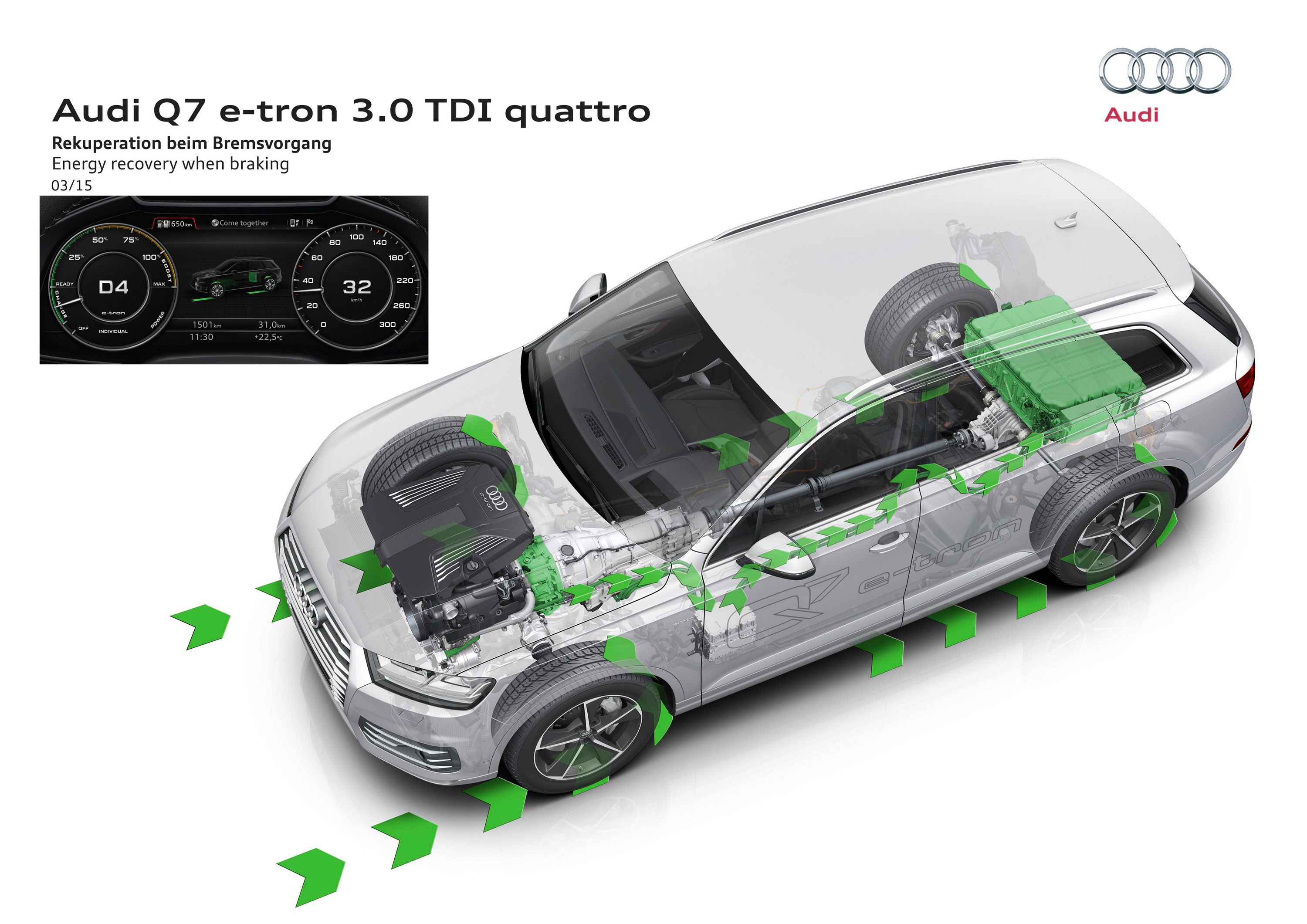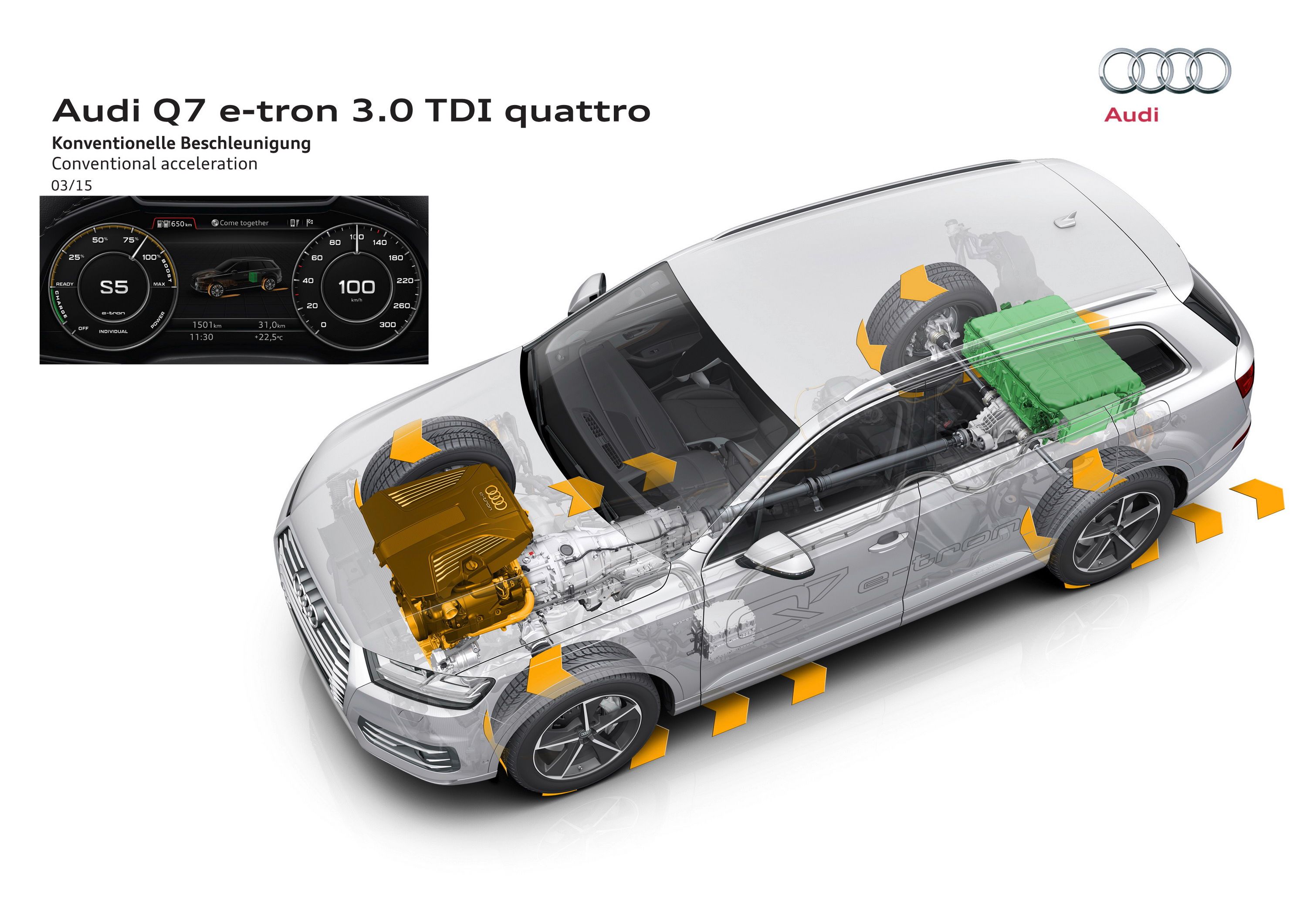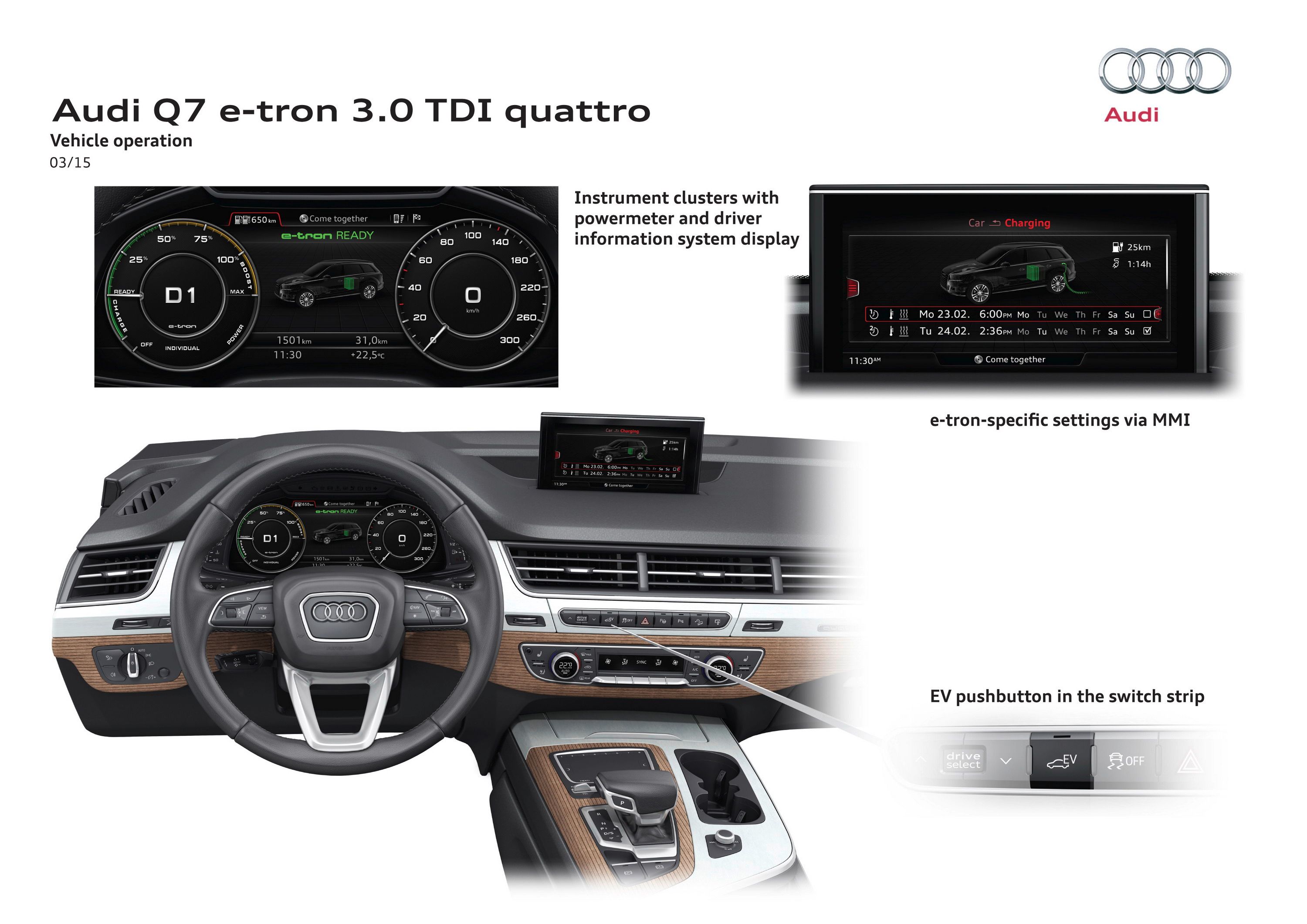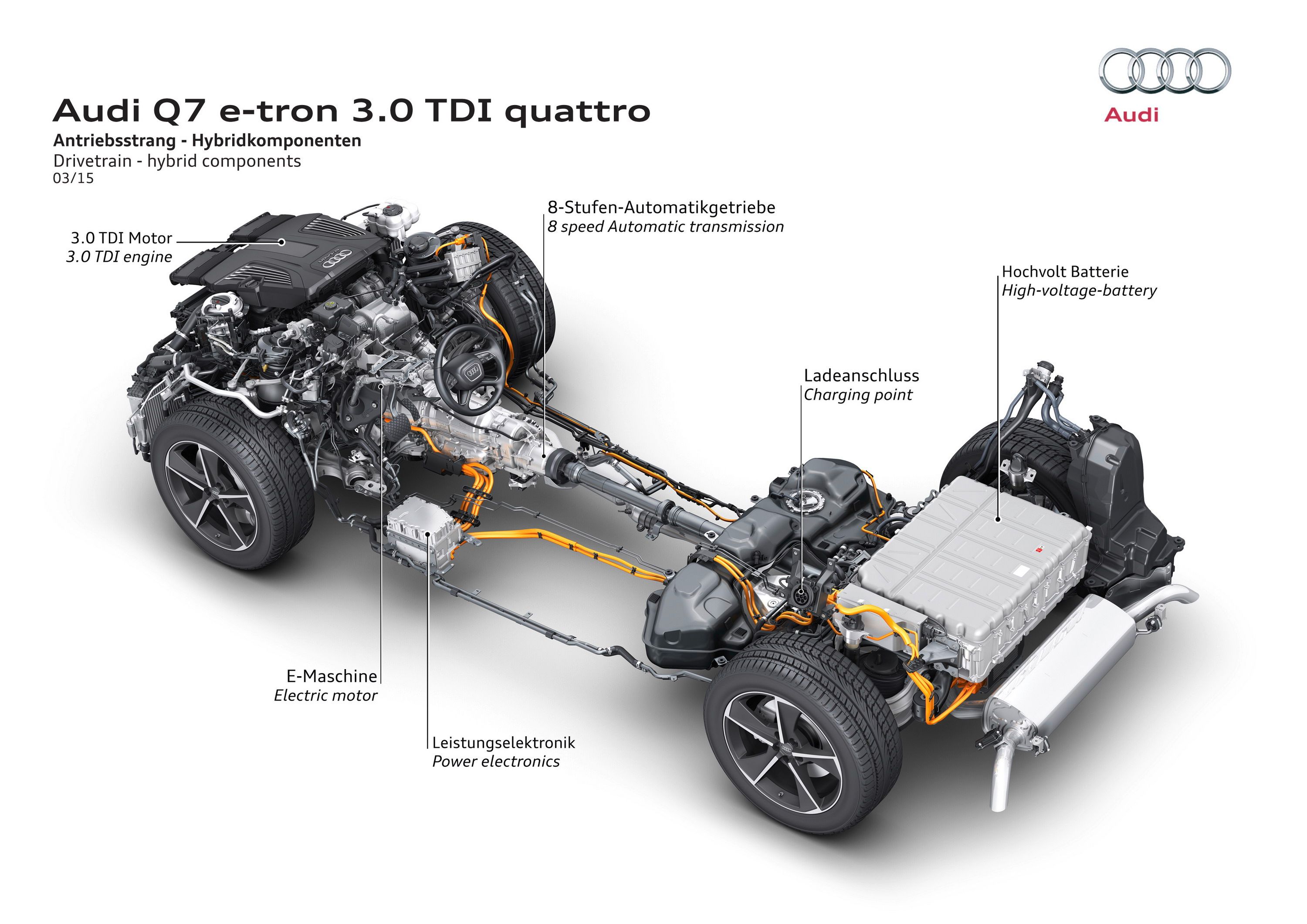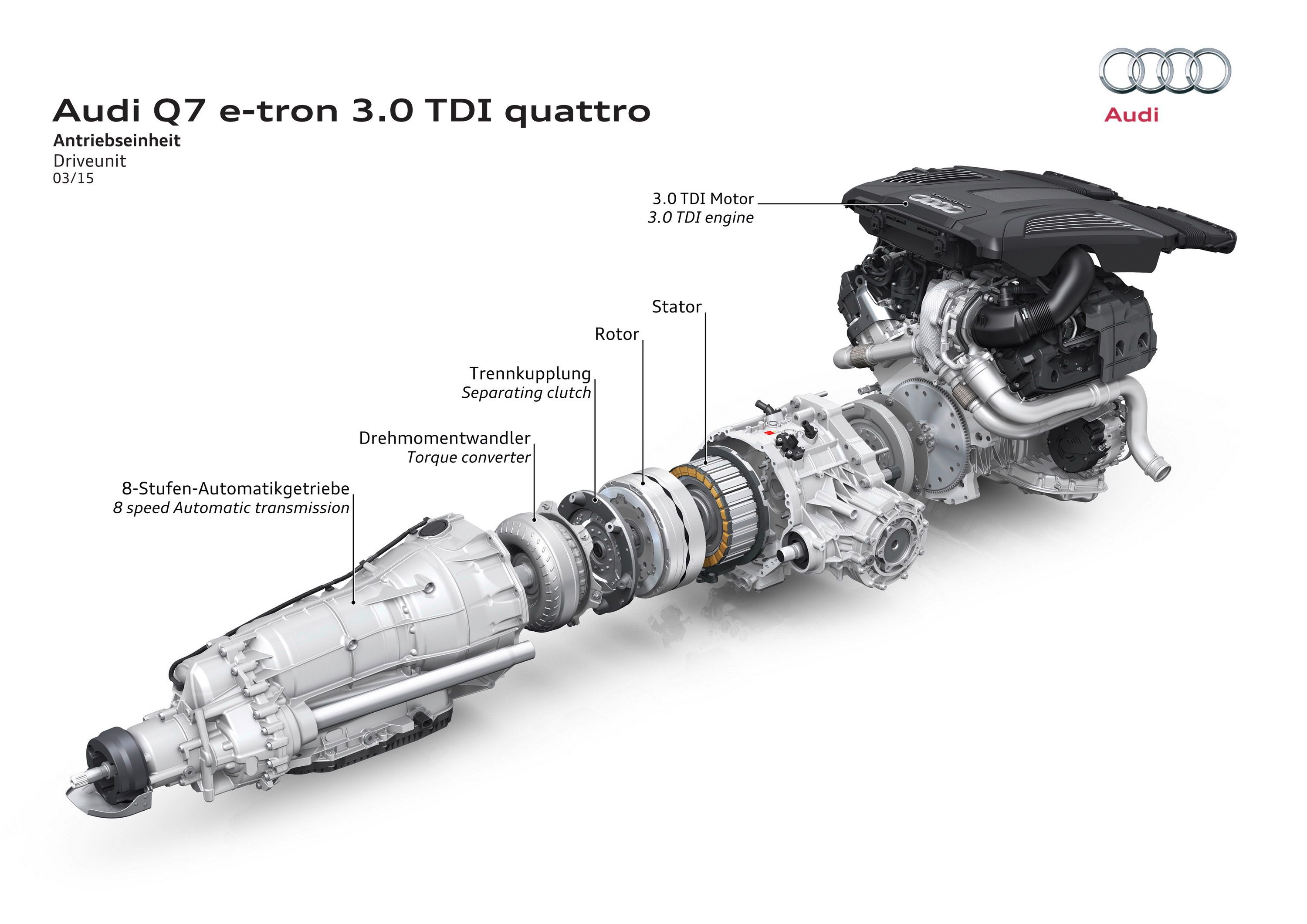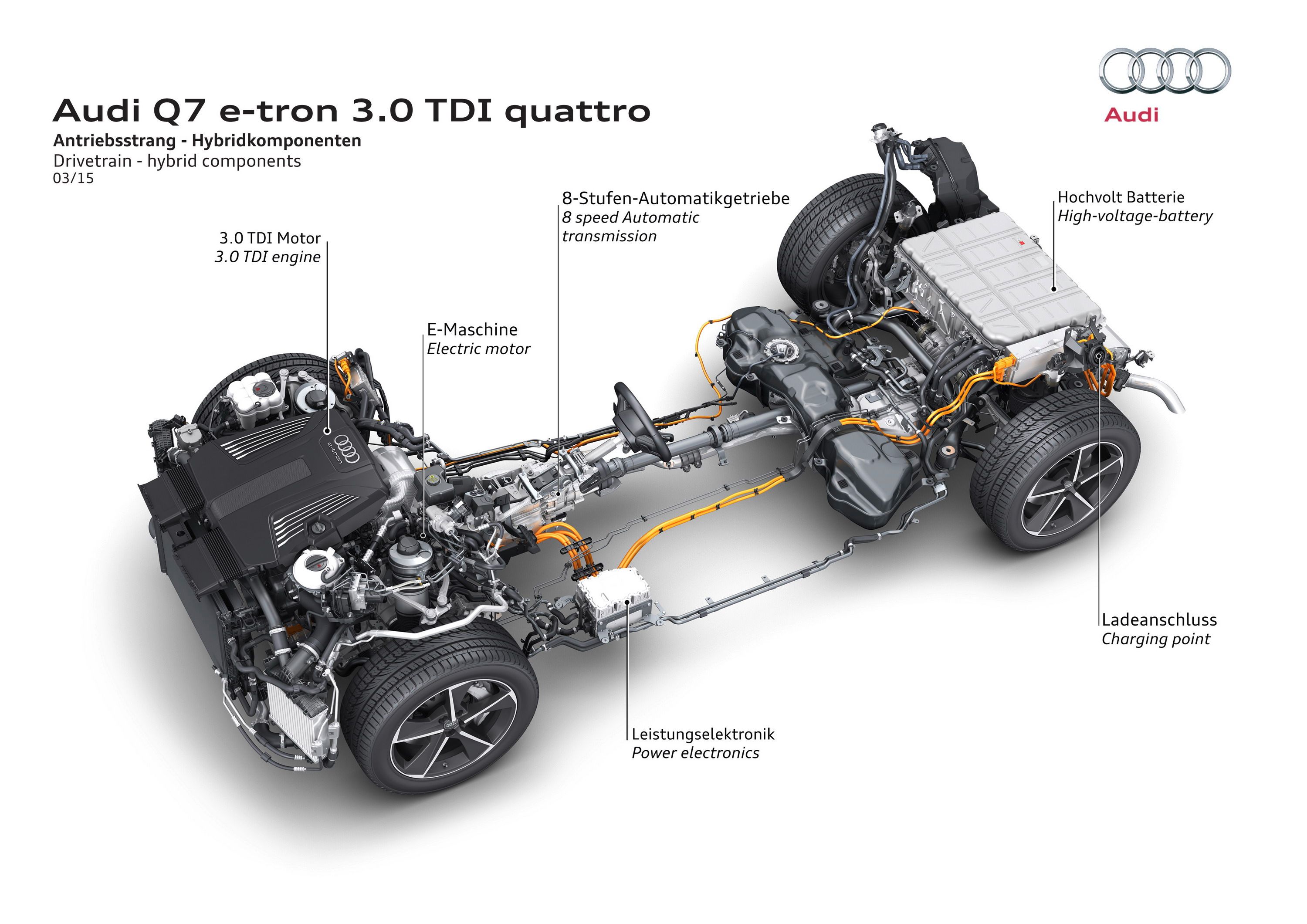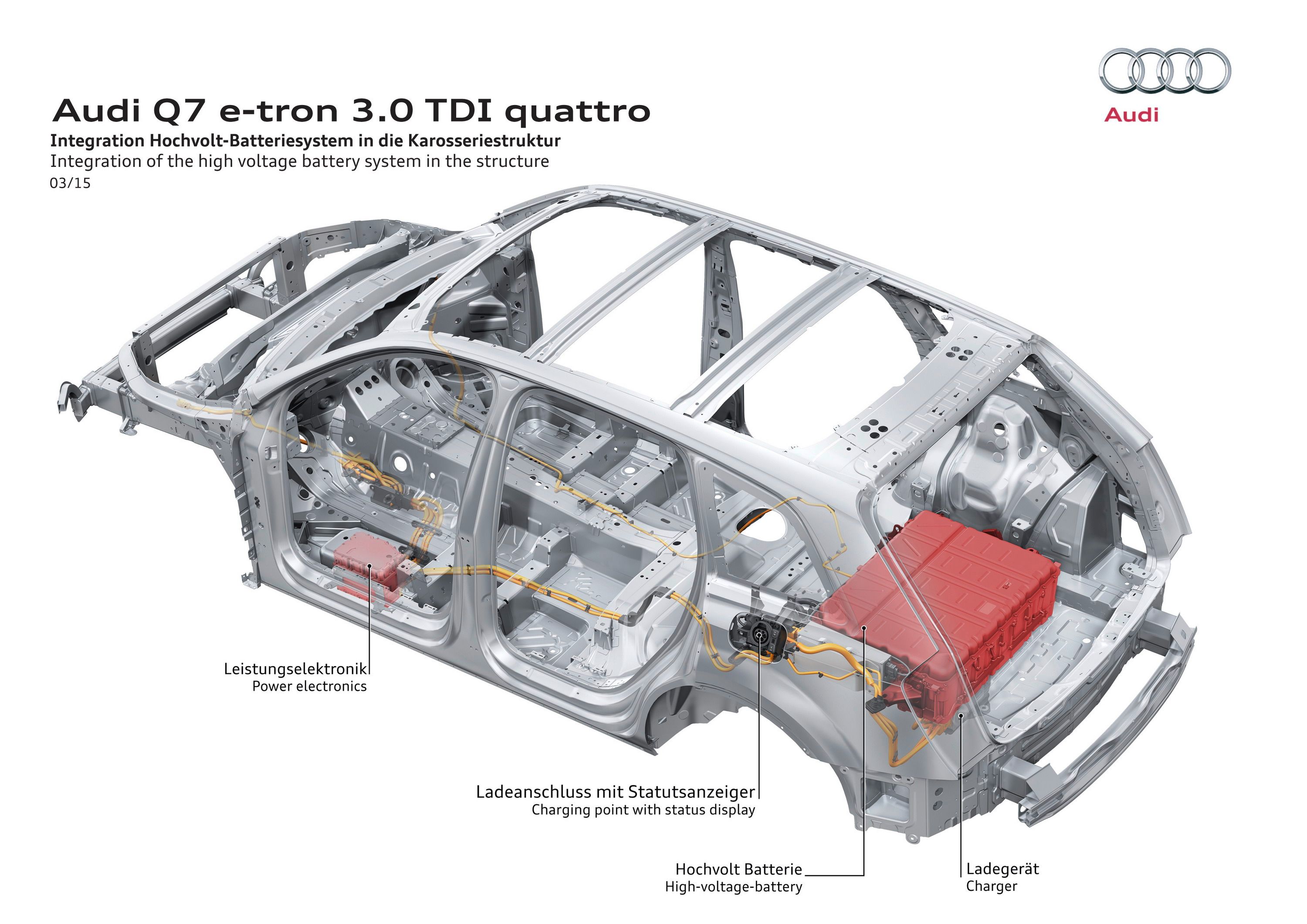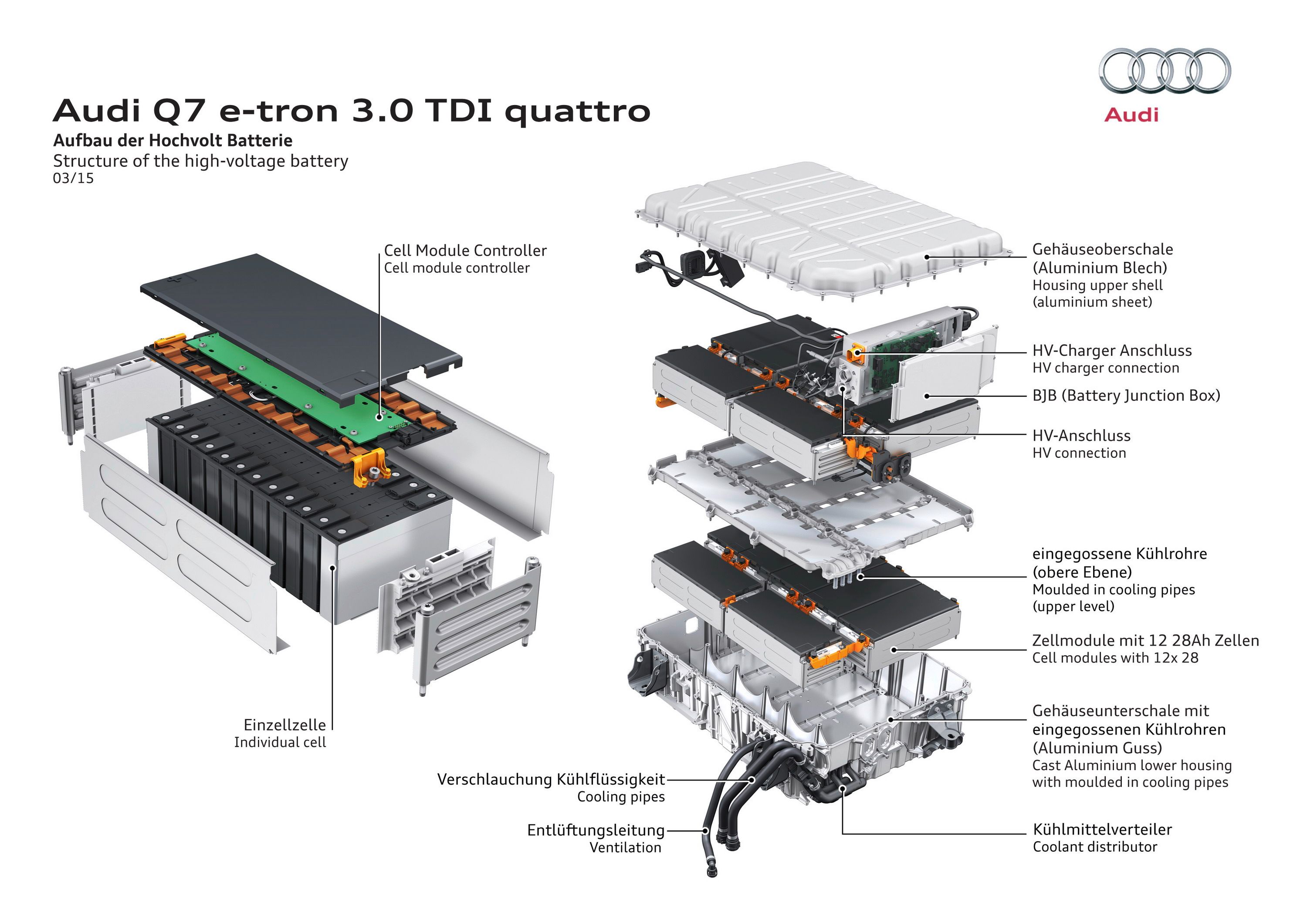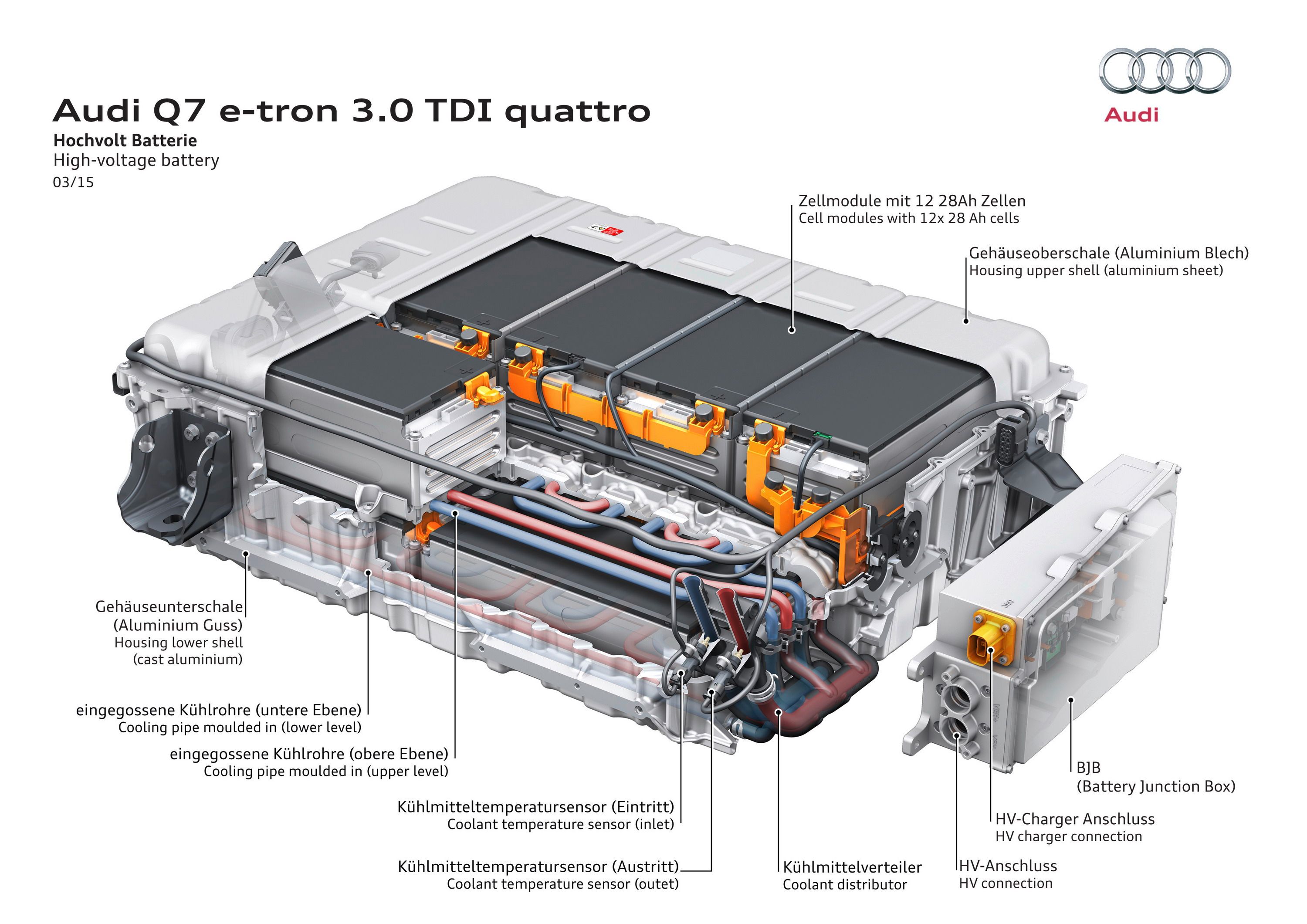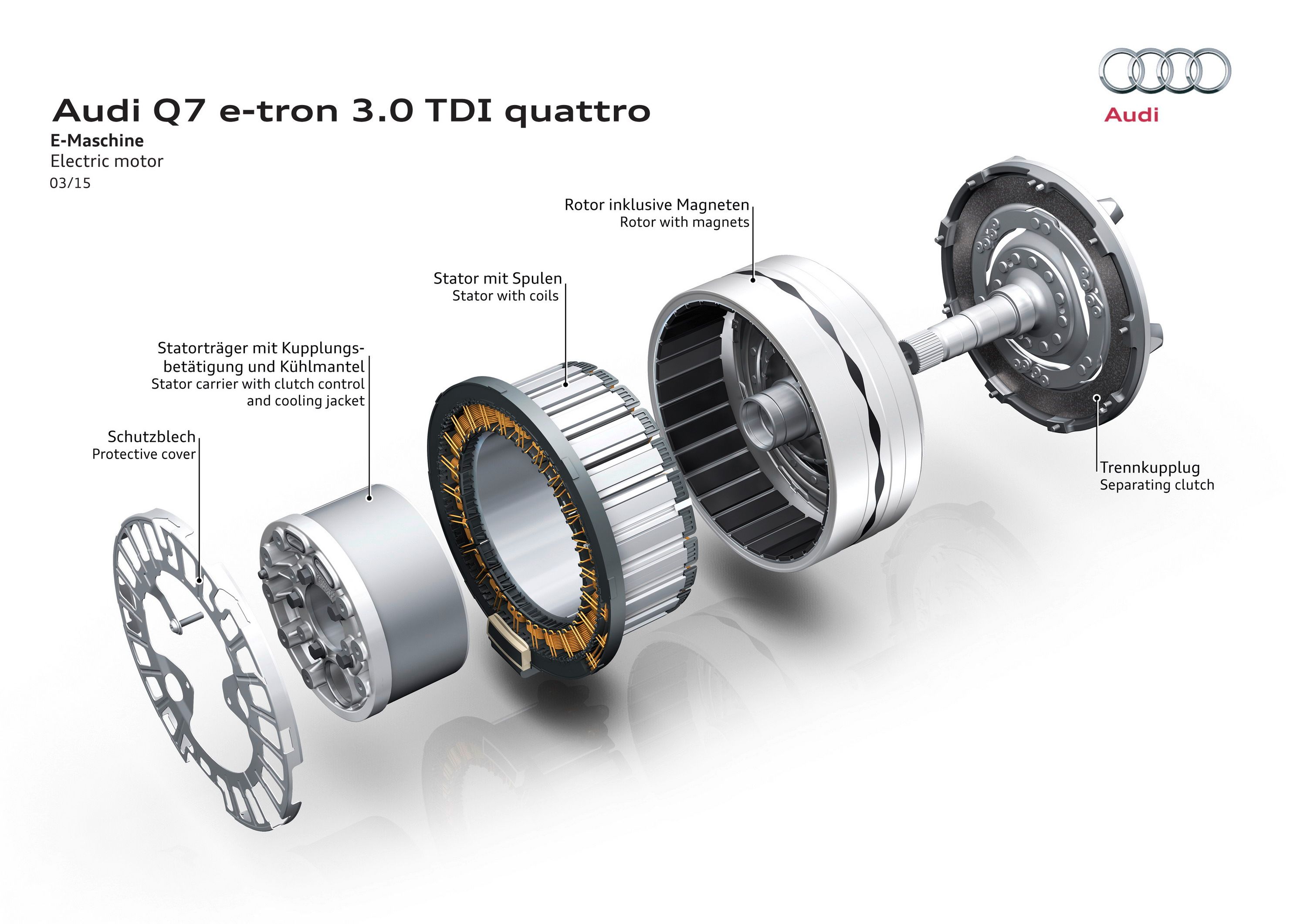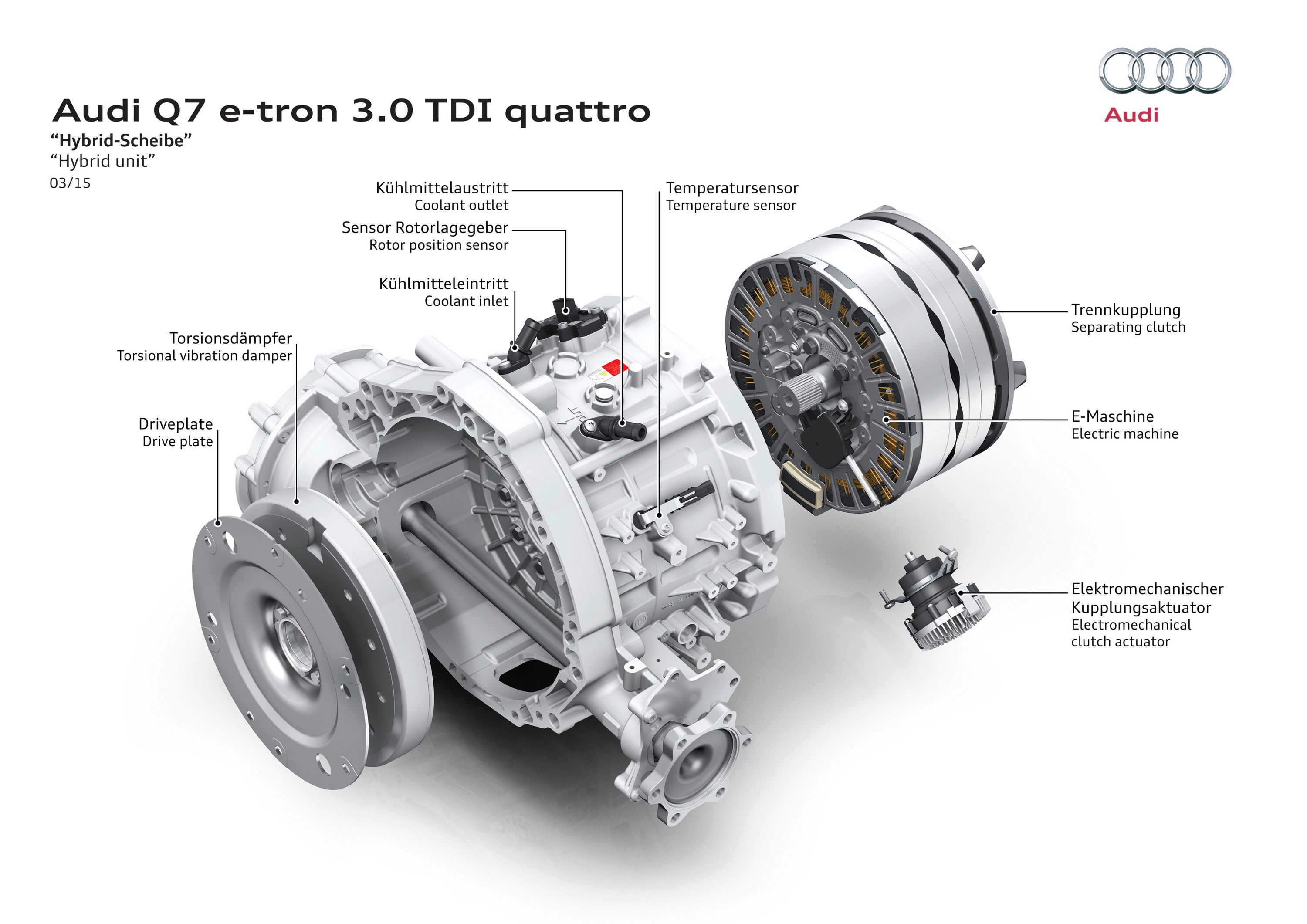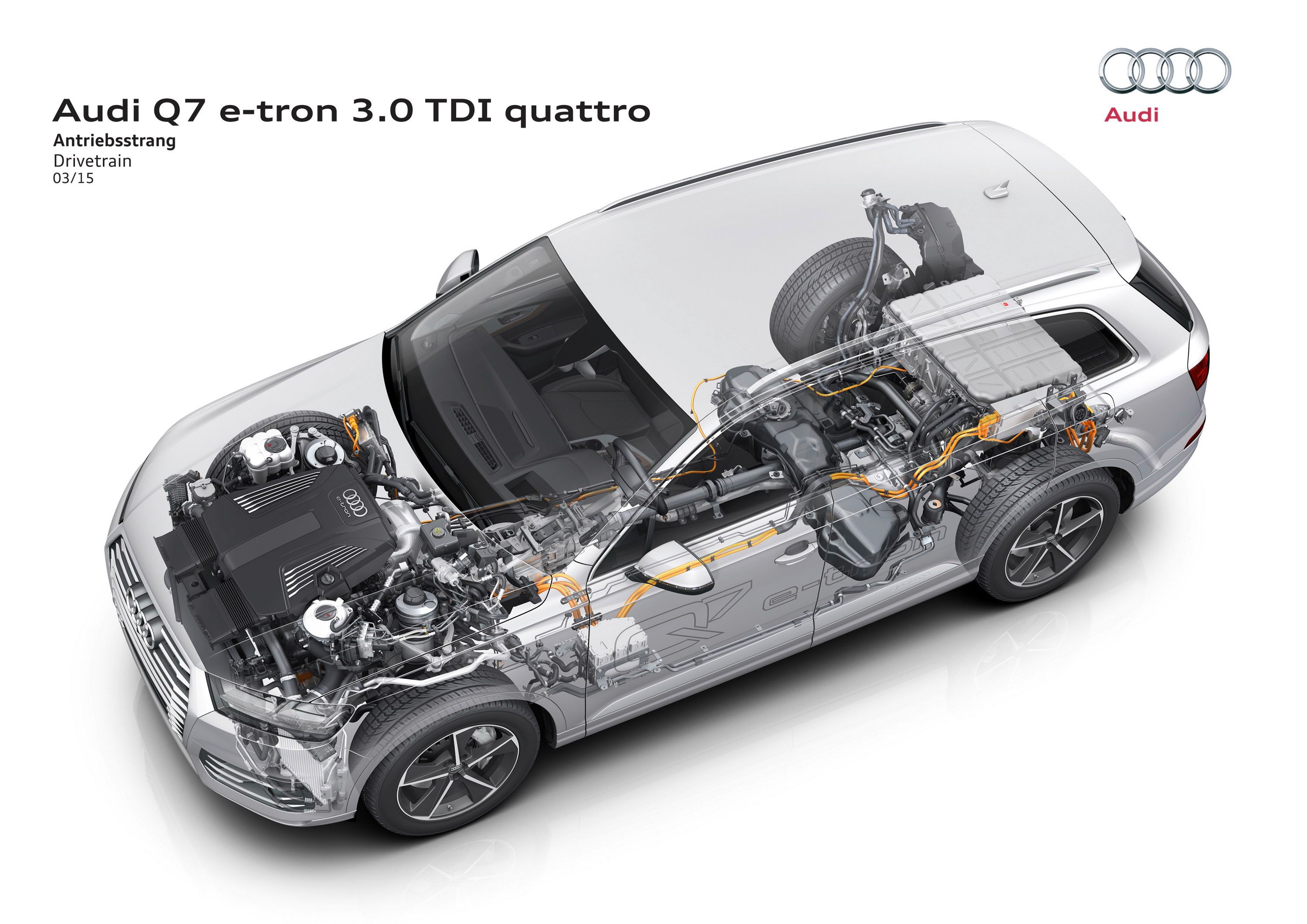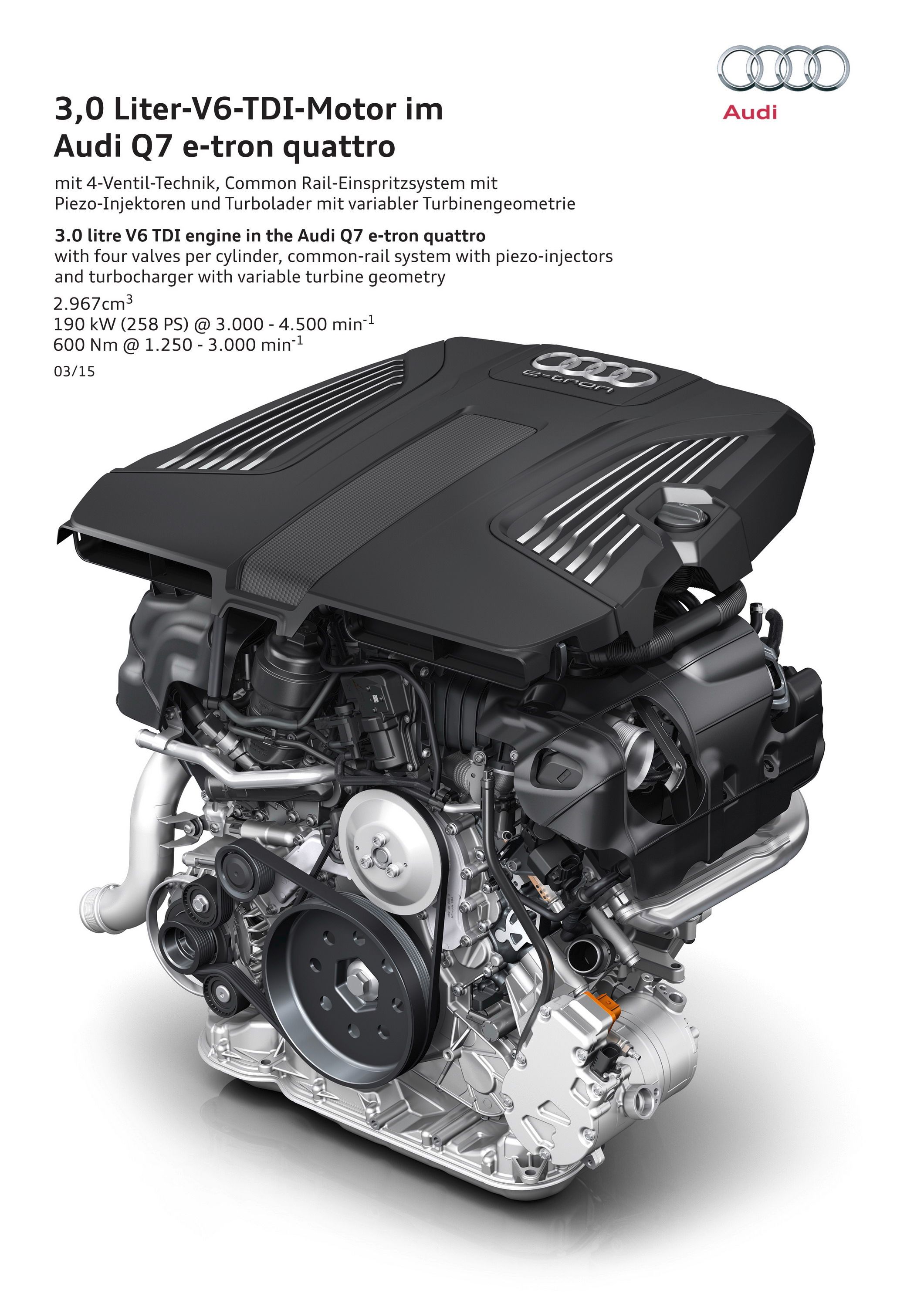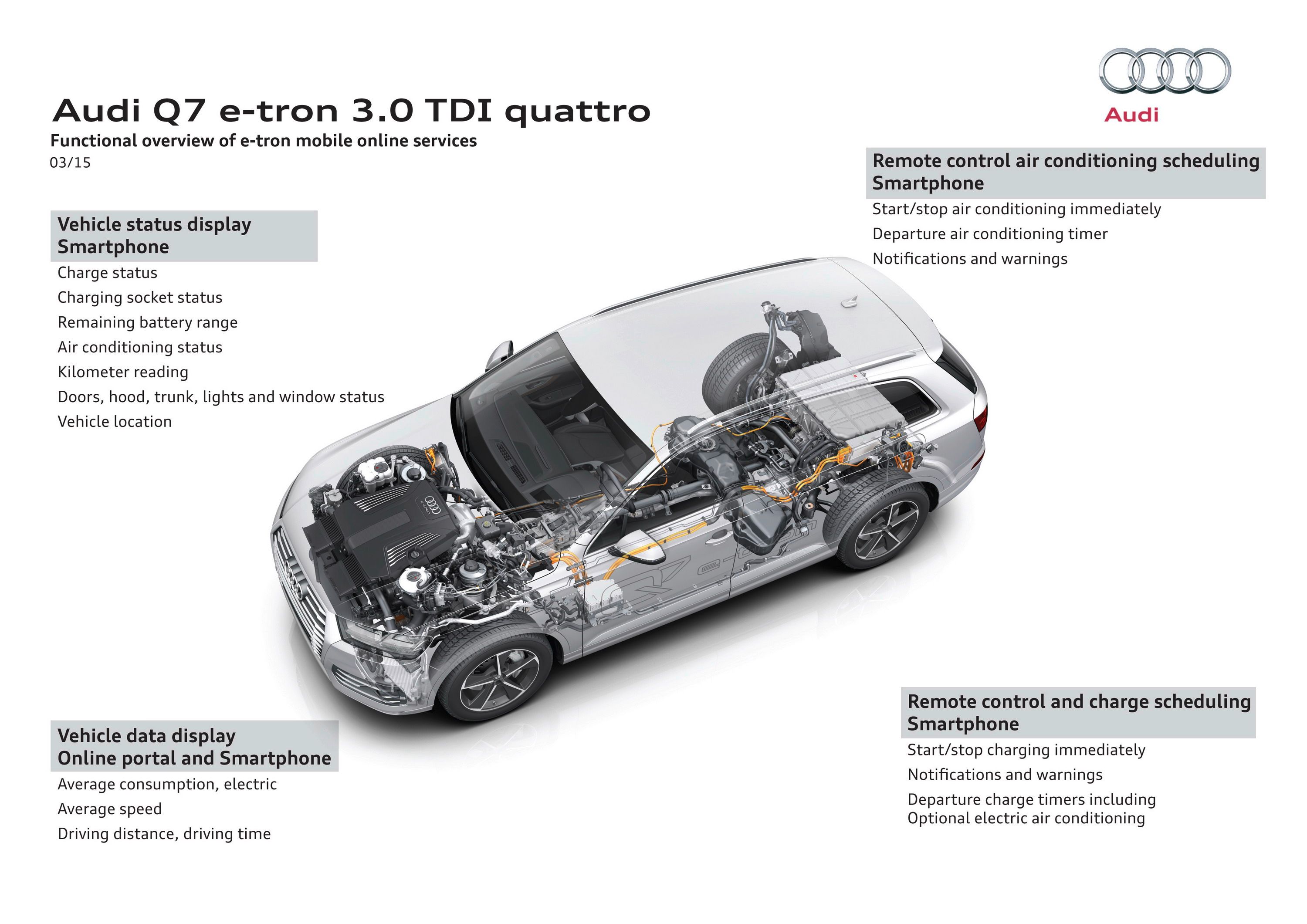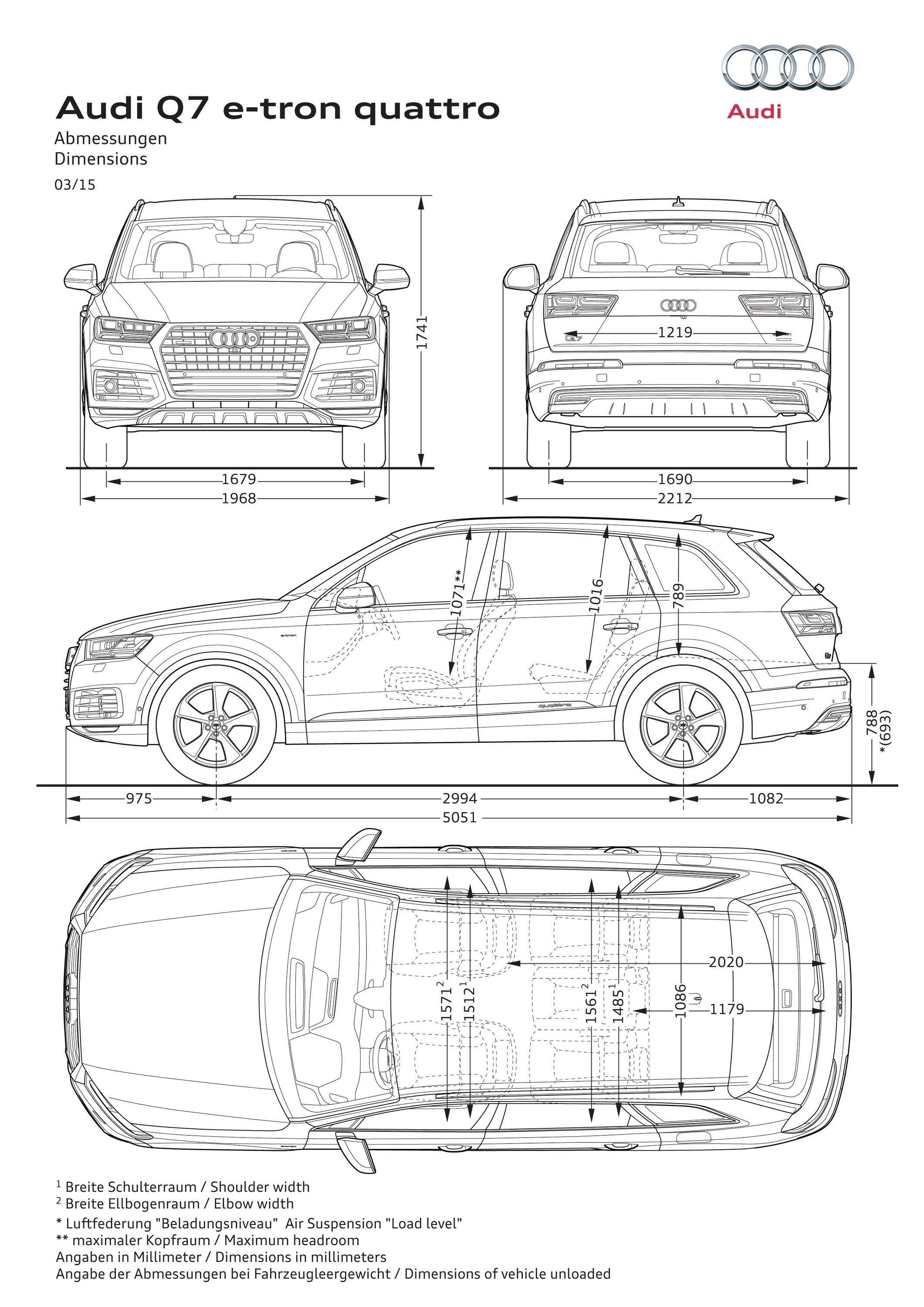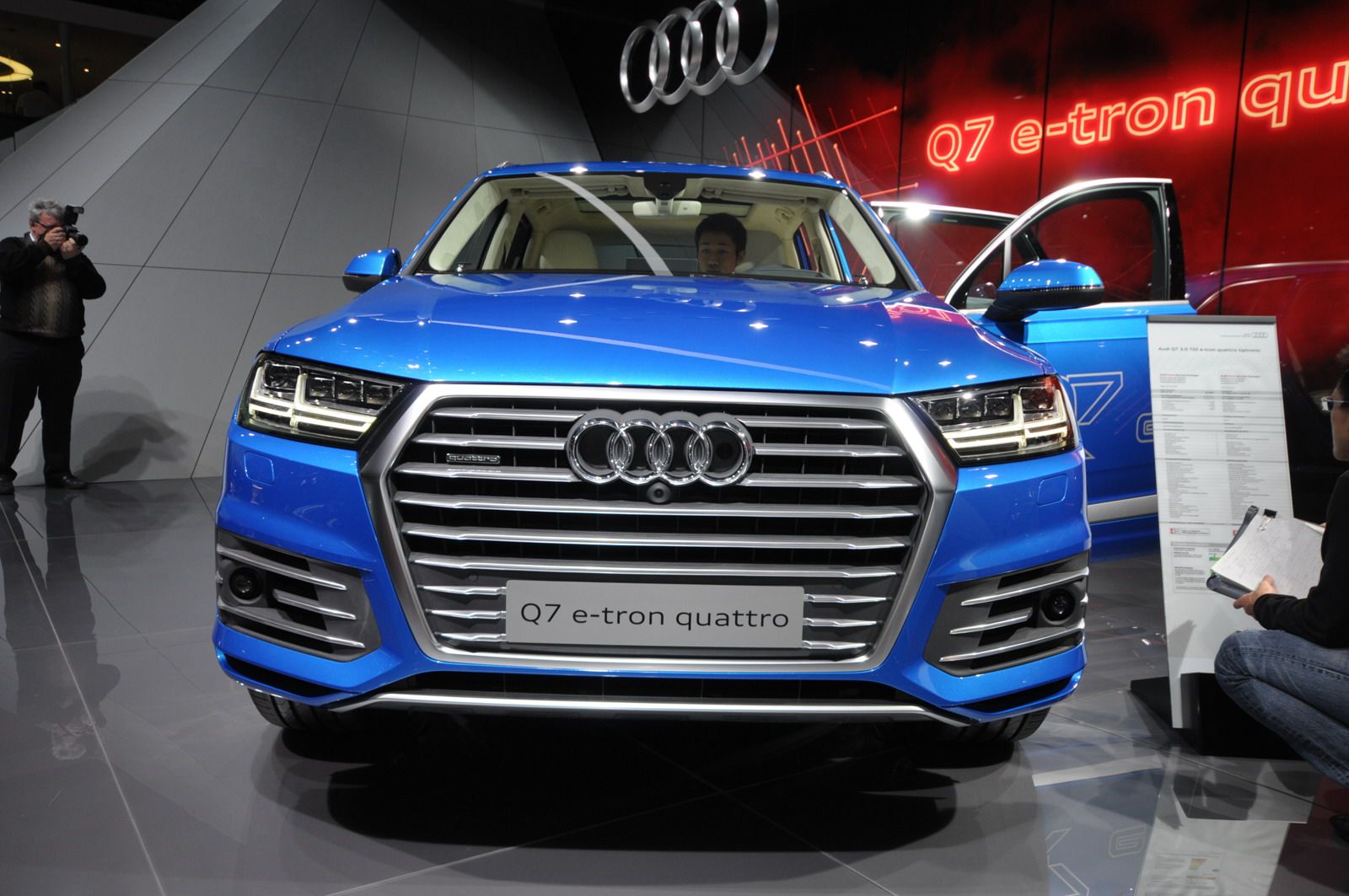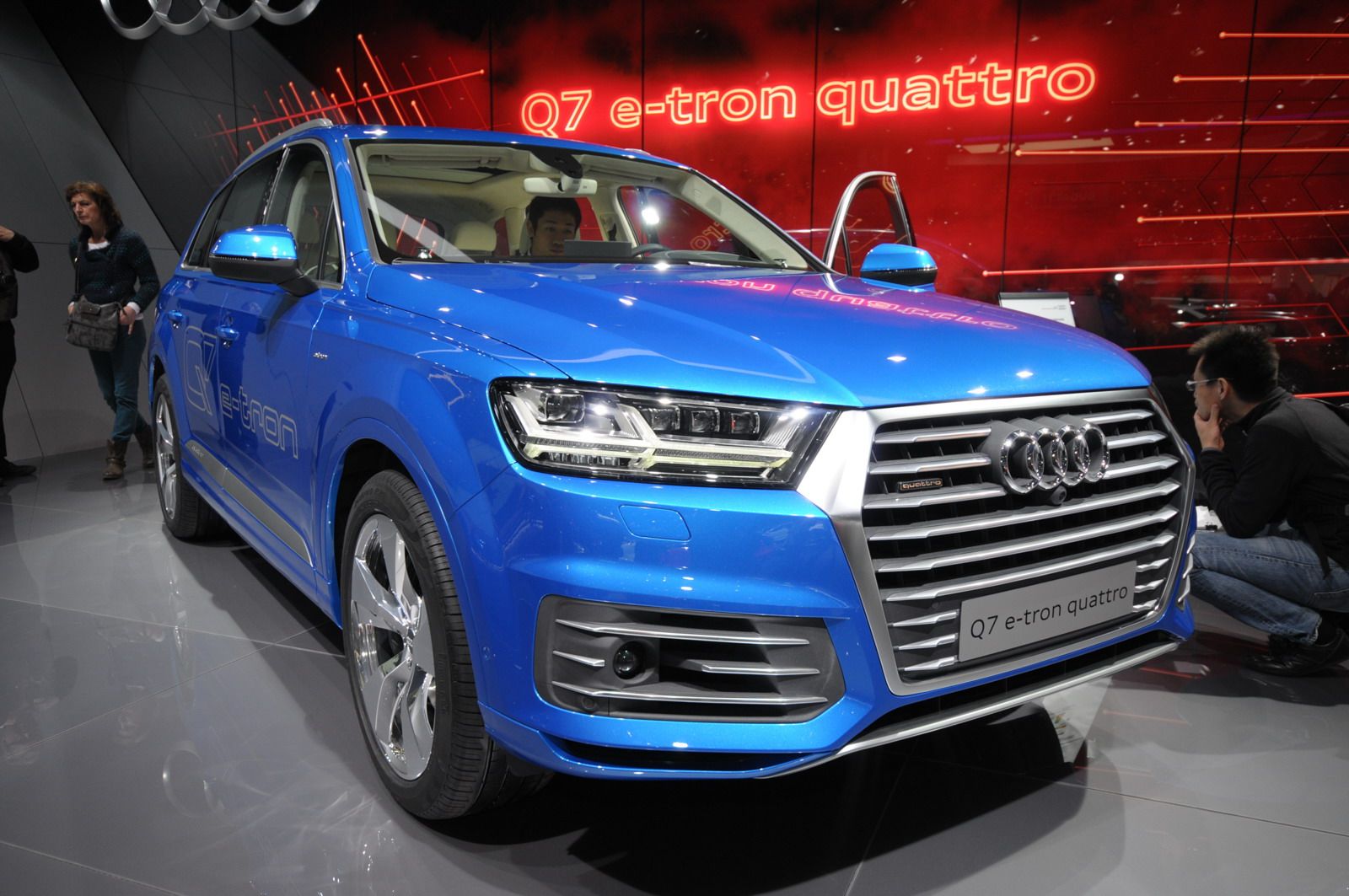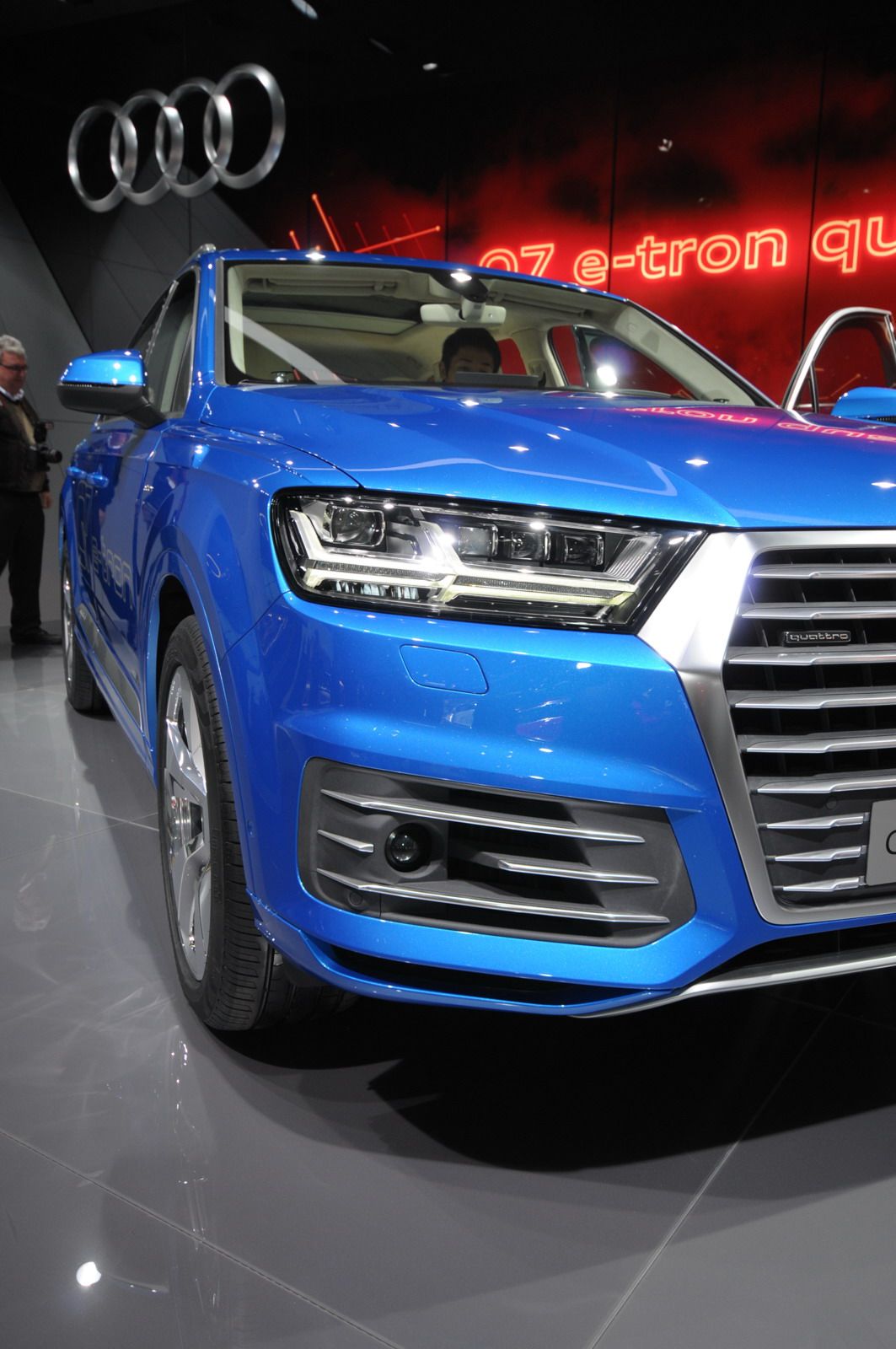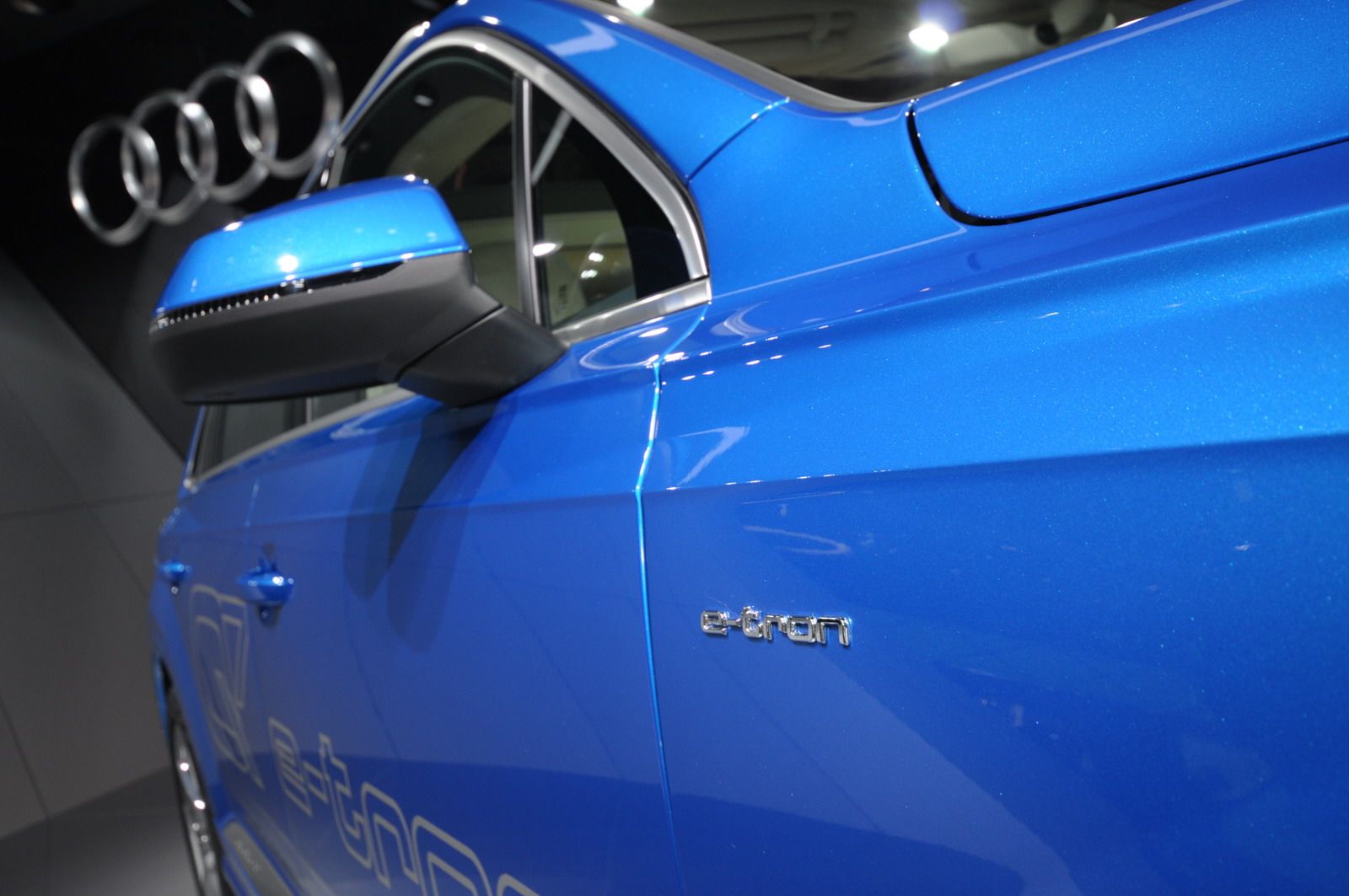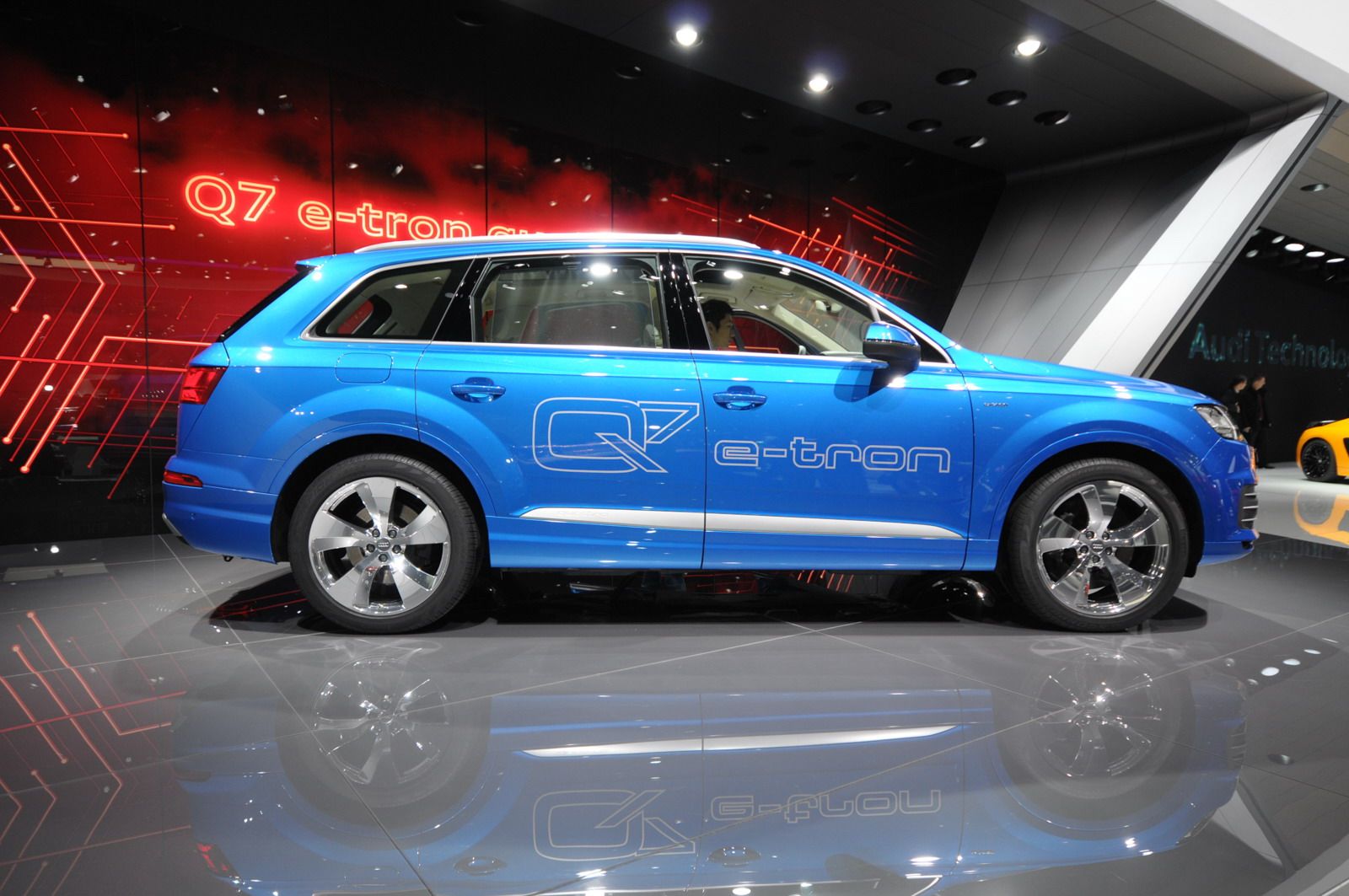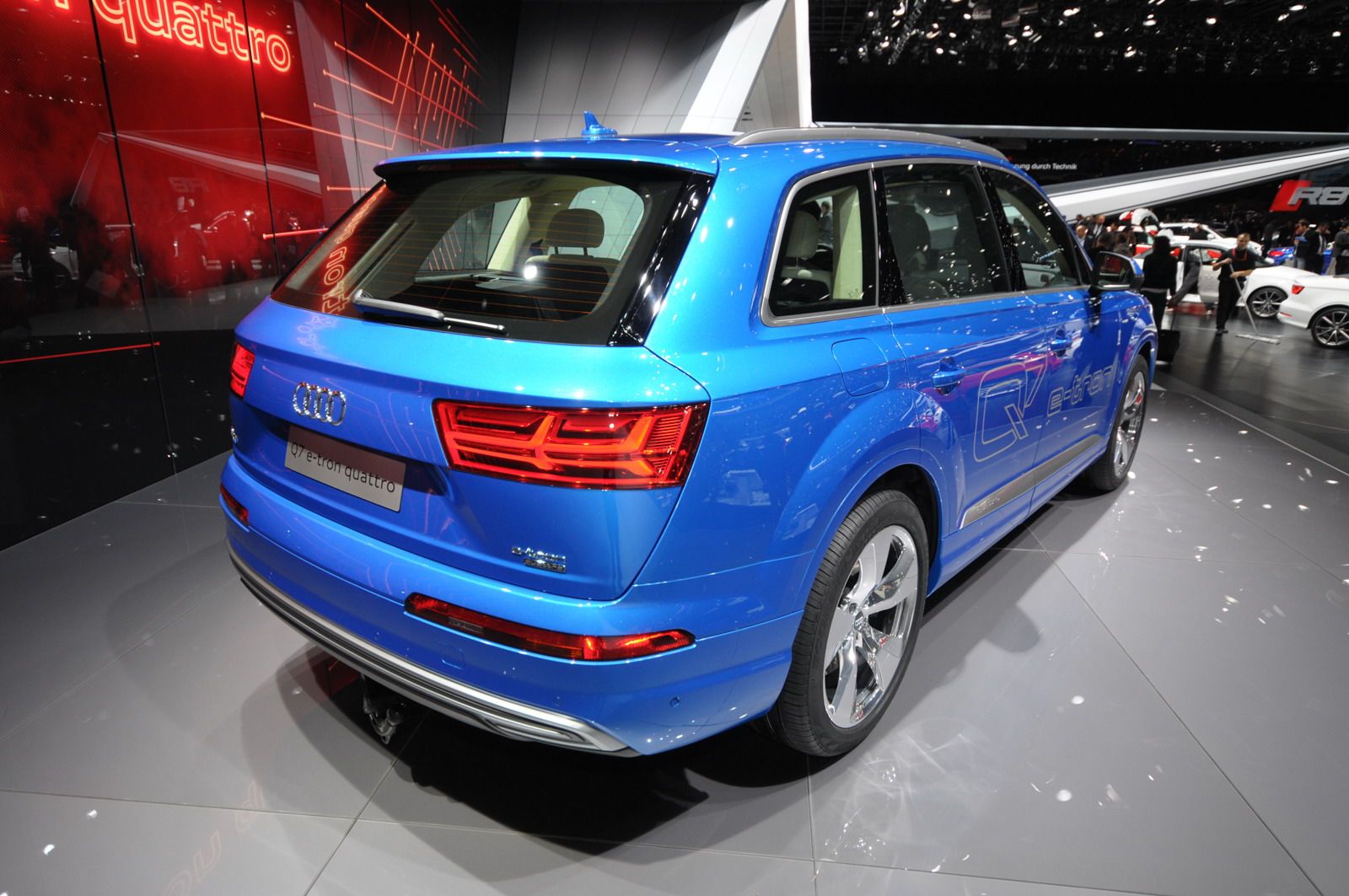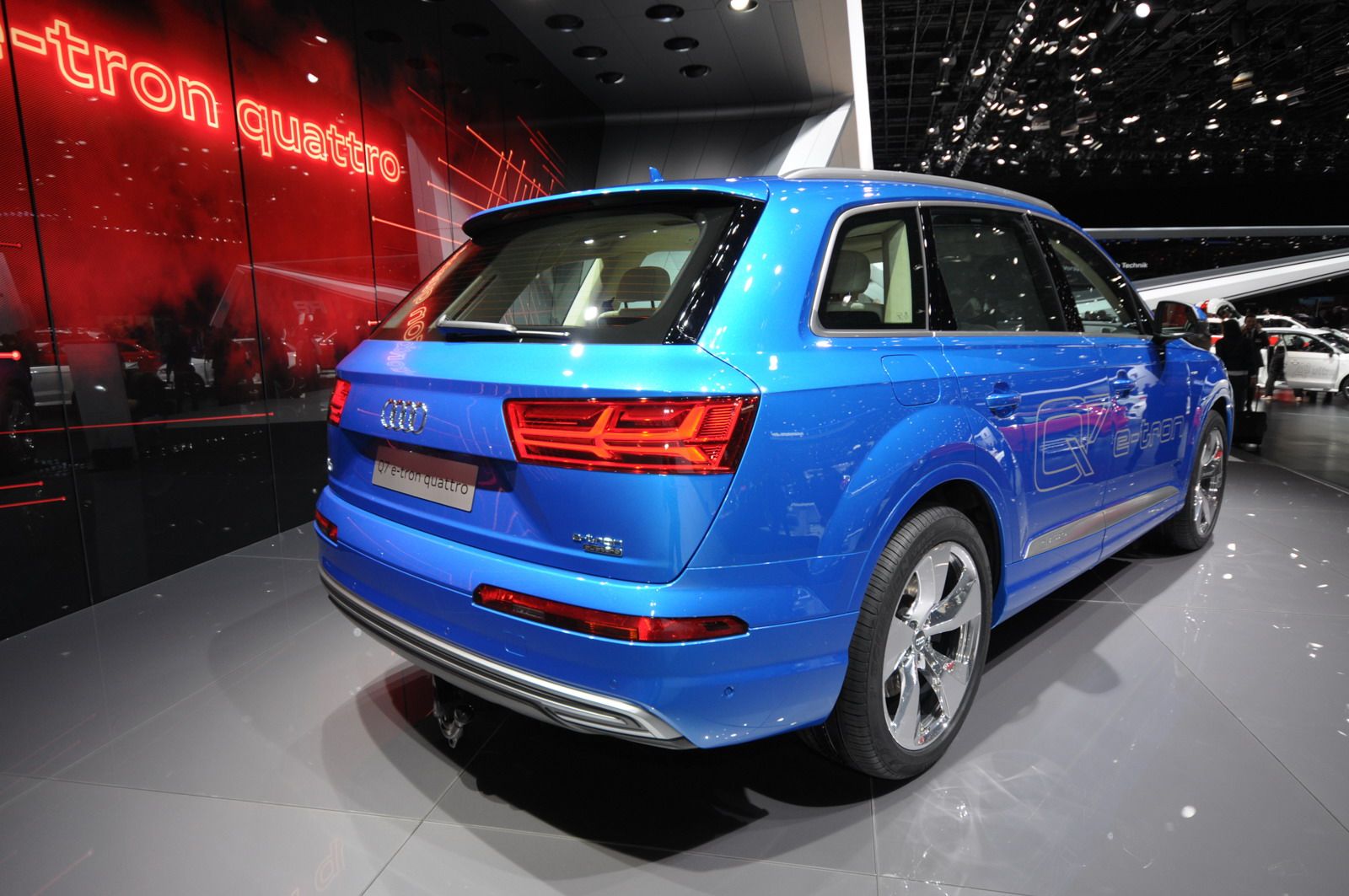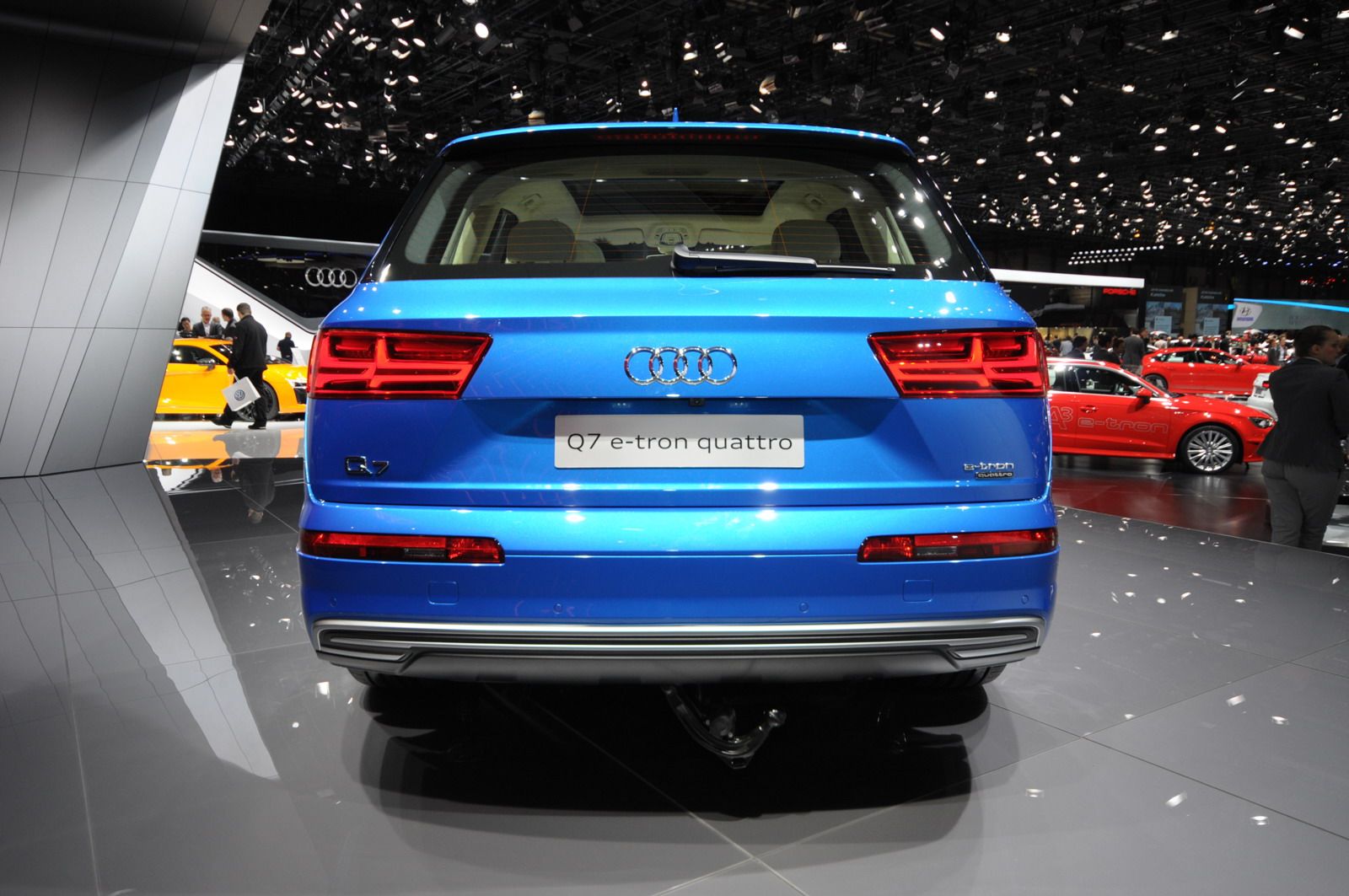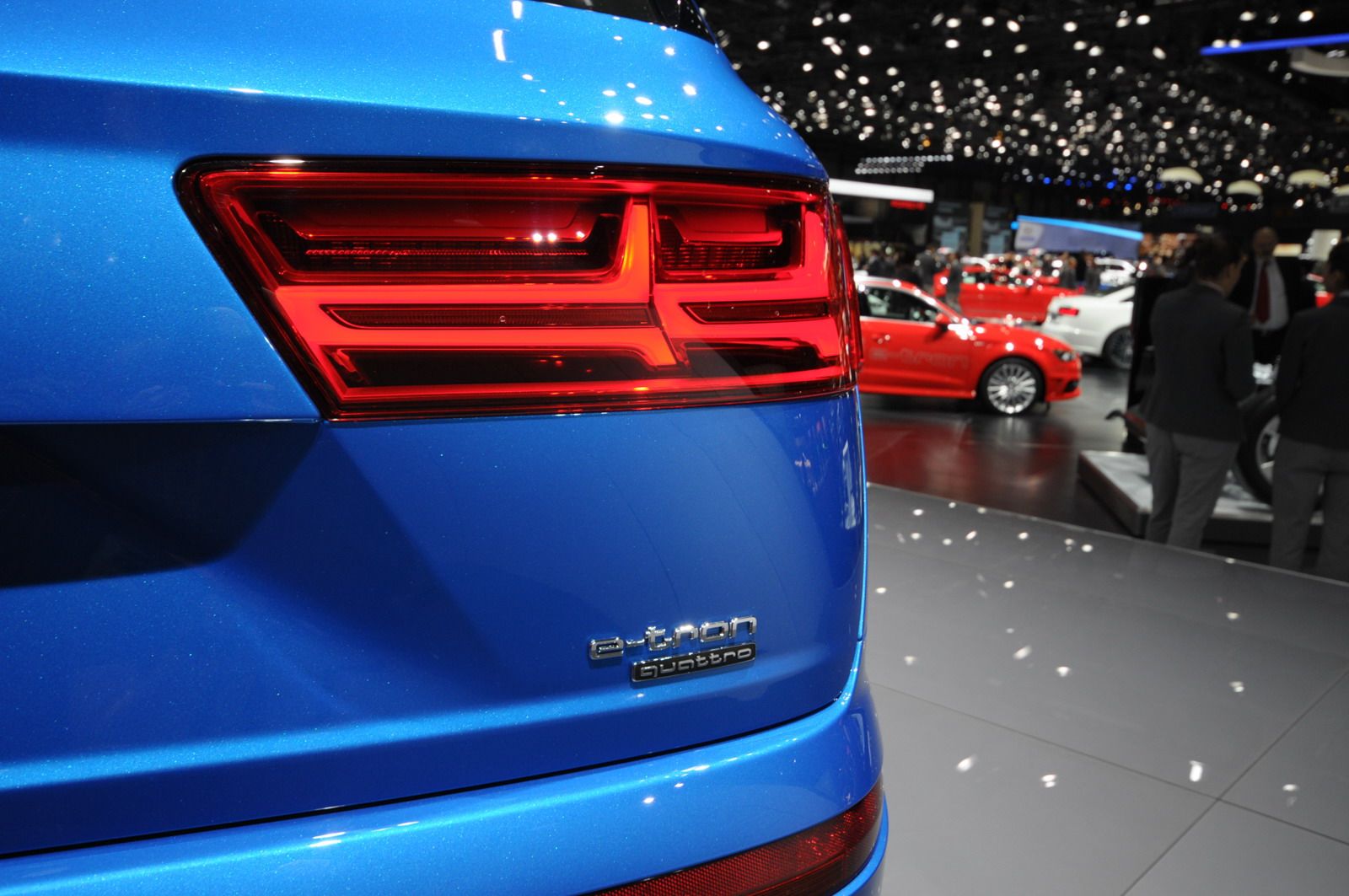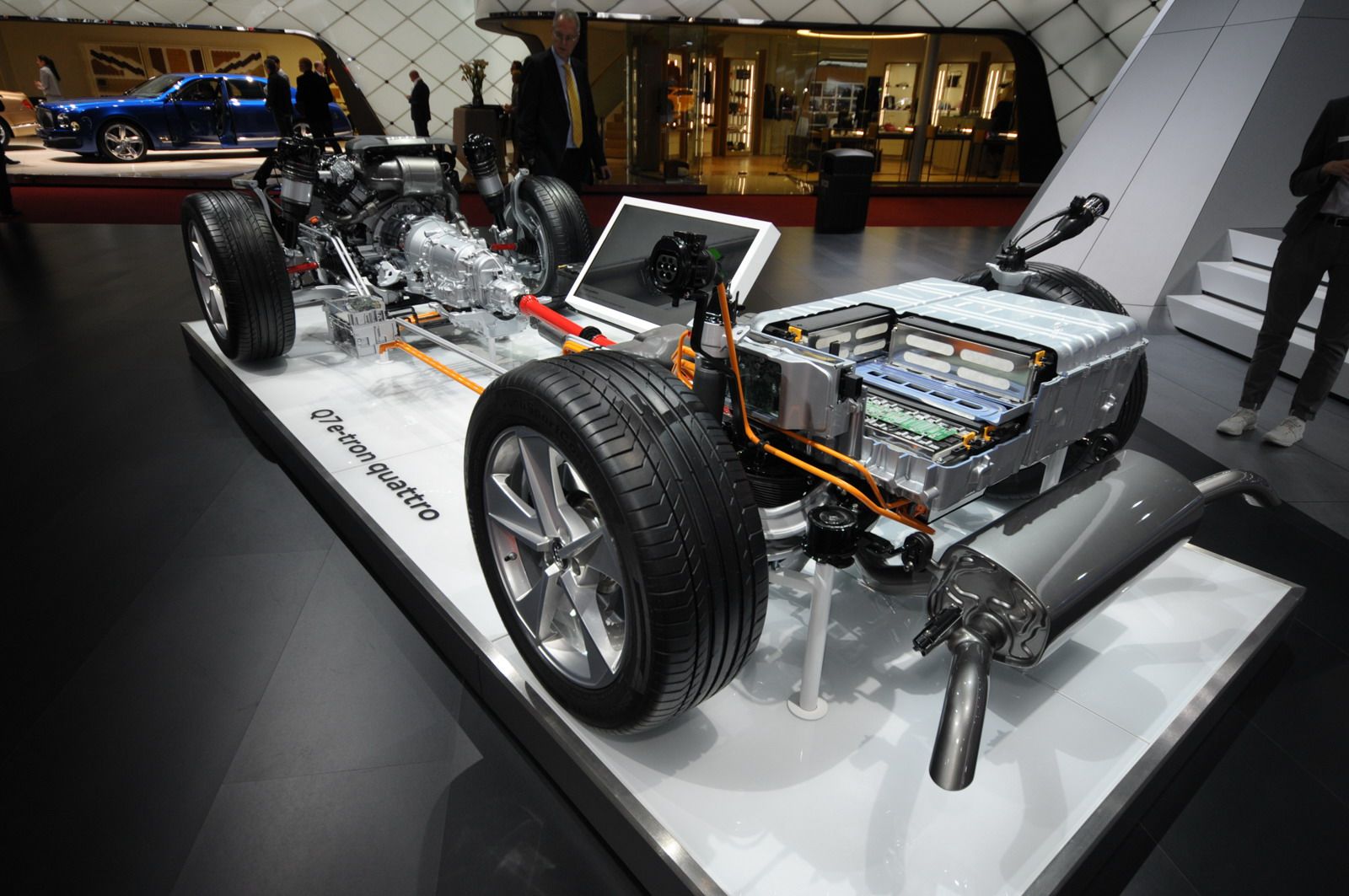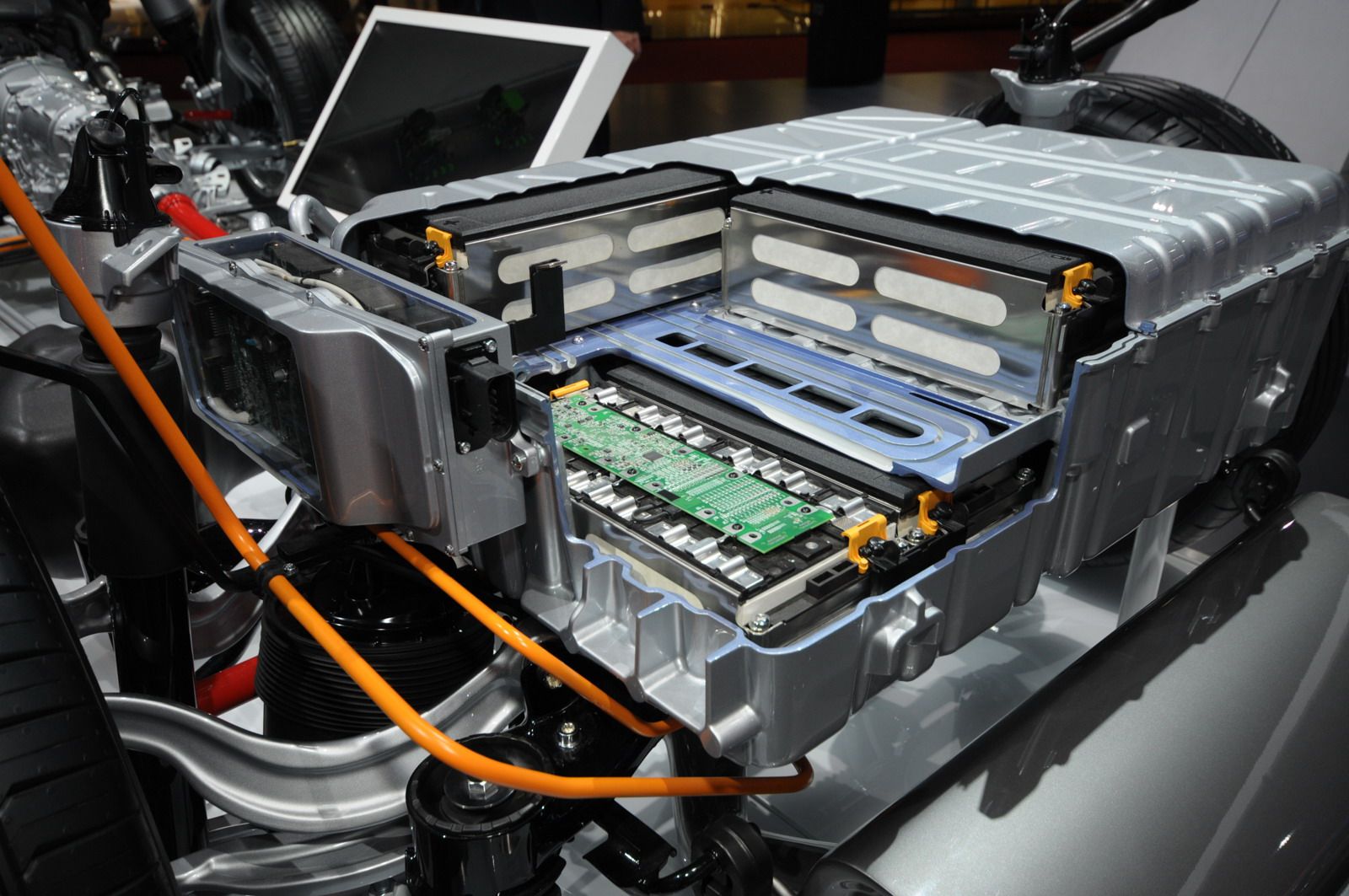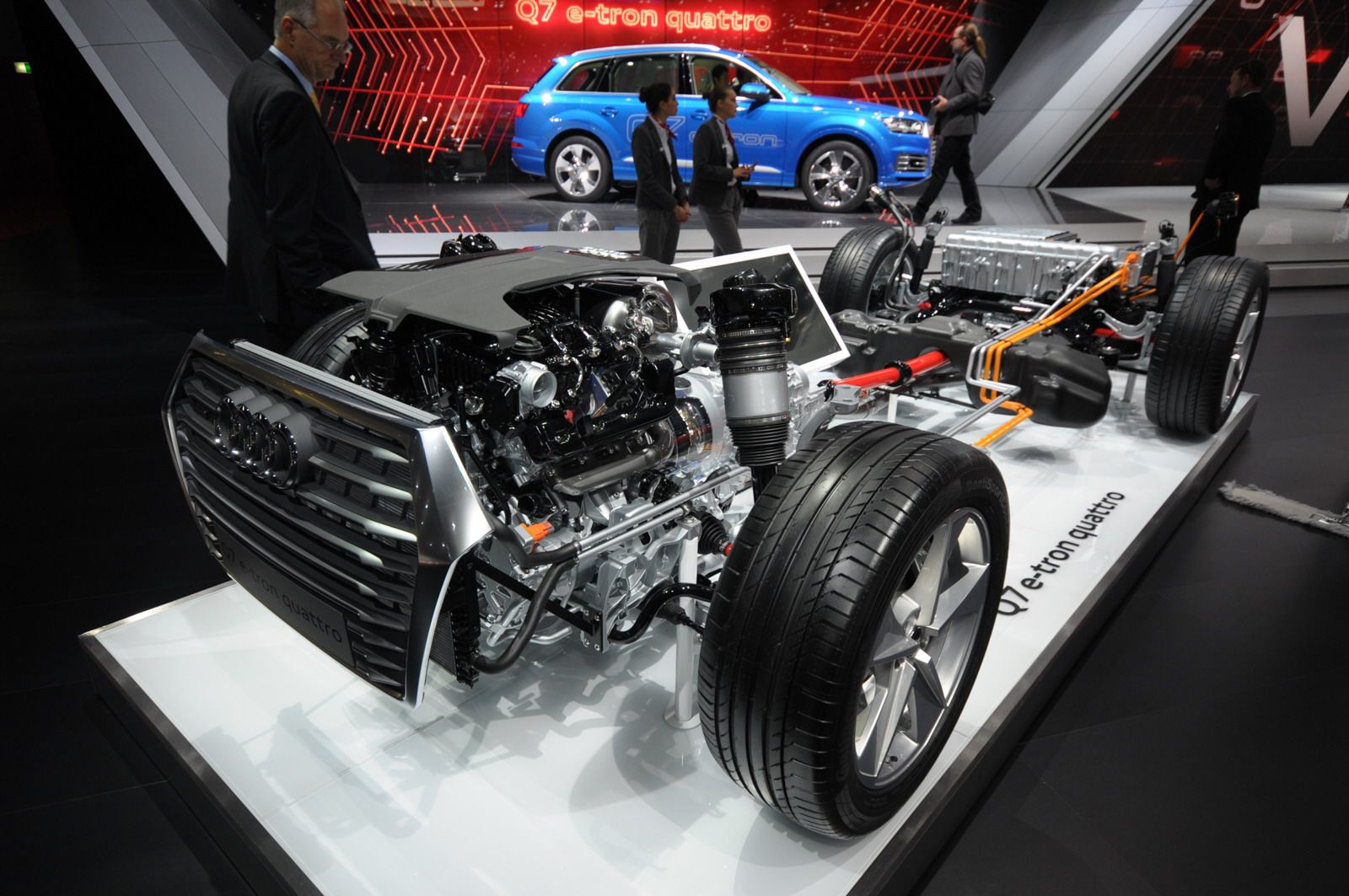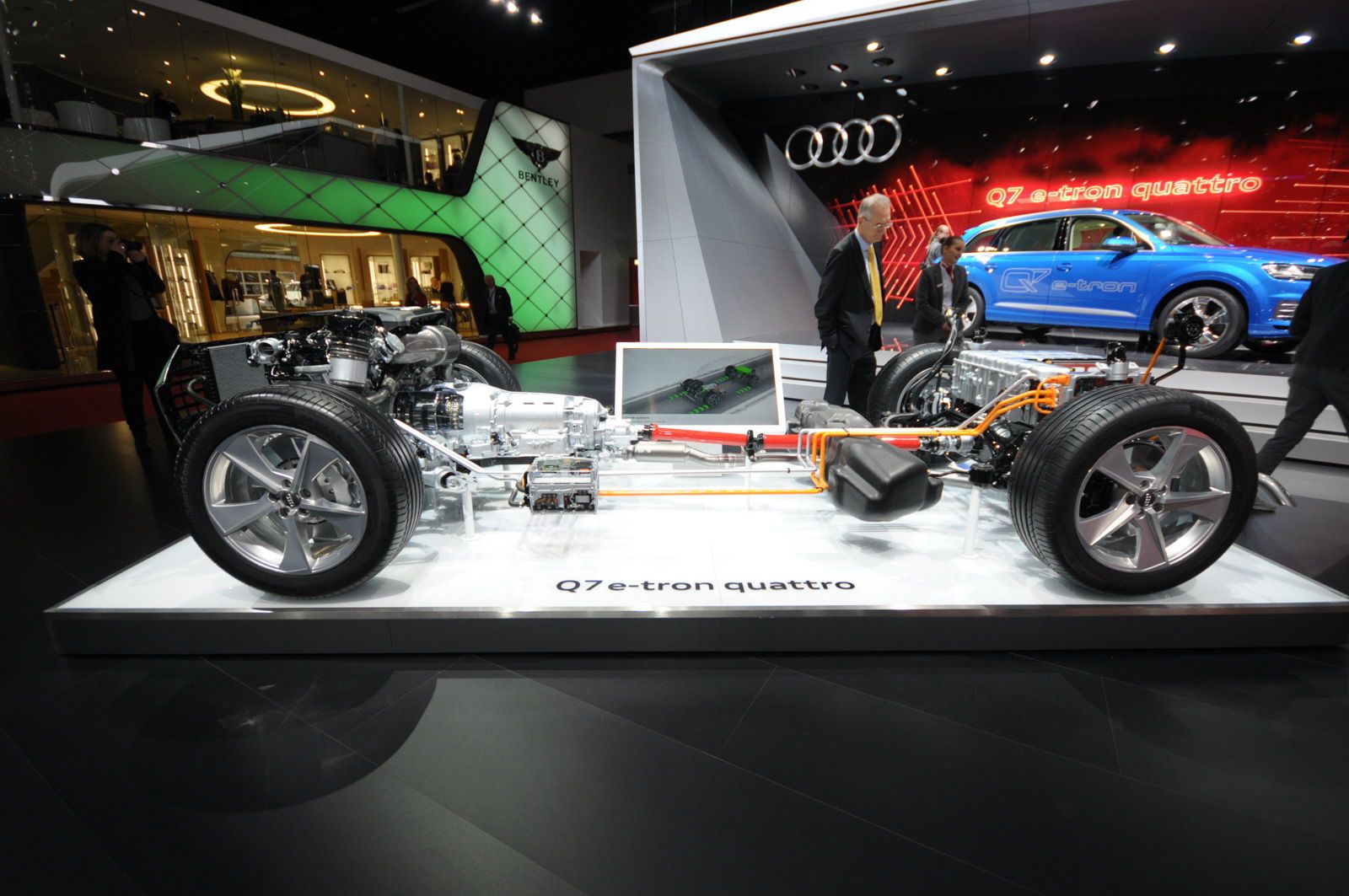Back in 2005, Audi->ke14 decided it was time to throw its weight around in the full-size SUV->ke145 market, unveiling the Q7->ke1083 at the Frankfurt Auto Show.->ke235 The vehicle was made available for purchase later the following year.
Based on the same VW->ke94 Group PL71 platform as the Vokswagen Touareg->ke321 and Porsche Cayenne,->ke212 the Q7 has good roots for offering a premium, luxury ride with ample interior space. It even comes with a dose of SUV-style sportiness for those who like a bit of speed with their size. As Audi’s first SUV, the Q7 has spawned a number of smaller crossovers, including the Q5->ke1666 and Q3.->ke2666 However, it remains Audi’s head honcho when it comes to crossovers.
Now Audi will offer the Q7 with a TDI plug-in hybrid drivetrain and quattro AWD. The Germans hope to retain the same levels of comfort, style, and speed as can be found in the non-electric variants, but with improved efficiency as well.
Called the Q7 e-tron quattro, this vehicle promises to point the way forward for the brand in terms of electrified drivetrains. Ingolstadt says this vehicle can do it all, but can it really?
Continue reading to learn more about the Audi Q7 e-tron 3.0 TDI quattro.
2016 Audi Q7 e-tron 3.0 TDI quattro
- Make: Array
- Model: 2016 Audi Q7 e-tron 3.0 TDI quattro
- Engine/Motor: V6
- Horsepower: 373
- Torque: 516
- Transmission: eight-speed tiptronic
Exterior
While most Audis take to the road with subtlety and understatement, the Q7 is a bit different. It’s still unmistakably an Audi, with stylistic elements similar to its sedan stable mates, including a single piece front grille, rectangular headlights, and uncluttered lines front to back. But the size of the Q7 adds a layer of boldness that’s uncharacteristic of the marque. It’s not the biggest SUV on the market, at just 16.6 feet in length, but the flared wheels arches and solid proportions still do a good job in making it stand out in a crowd.
Furthering this are a few touches that are unique to the Q7 e-tron quattro. The single-frame grille, air intakes, double arrow headlights, and rear diffuser are reminiscent of other models in Audi’s lineup, but incorporate their own exclusive flair. The 19-inch wheels are also unique to this model.
To keep the weight down, Audi constructed several components from hot-formed steel and aluminum, the same process used in the conventional Q7. The drag coefficient is 0.34, which is actually quite good for a vehicle this size.
Exterior Dimensions
|
Length |
5,050 MM (16.6 ft) |
|
Wheelbase |
2,990 MM (9.8 ft) |
|
Width |
1,970 MM (6.5 ft) |
|
Height |
1,740 MM (5.7 ft) |
Interior
Audi boasts a variety of bests when it comes to features on this new SUV, including the introduction of a new thermal management system with an integrated heat pump designed to regulate interior temperature levels with unprecedented levels of efficiency. Waste heat from the electrical drive components is pumped into the cabin, extending electric range up to 20 percent and keeping passengers comfy. There’s also the standard e-tron services from the Audi connect portfolio that allow for remote operation of electric charging and air conditioning via smartphone.
Audi claims that the Q7 e-tron has the most spacious interior in its segment. The three rear seats come with adjustable backrests and can be moved front to back, while the lithium-ion battery pack has been placed to save space. The luggage compartment can swallow 31.4 cubic feet of stuff in a normal configuration, and up to a maximum of 73.3 cubic feet. An electrically operated tailgate is standard.
Cabin equipment is extensive and advanced. The Q7 e-tron quattro comes with standard MMI navigation plus, which uses the Audi connect Internet module to pull nav data and real-time traffic information, then integrates with the hybrid management system to select the most fuel-efficient choice of four driving modes. A predictive efficiency assistant is there to facilitate, while operation of the system is conducted via touchpad or voice command.
Infotainment features include a second-generation modular platform with an NVIDIA Tegra 30 graphics chip. The Q7 e-tron quattro comes with standard wifi Internet access through LTE. An Audi tablet mounted in the rear helps entertain passengers, while a 3D sound system from Bose and Bang & Olufsen provide the tunes. Mobile phones are saved from death through the Audi phone box inductive charging station.
The Audi virtual cockpit comes standard, with a fully digital gauge cluster set in a 12.3-inch high-resolution display. Information like the power meter, tachometer, energy flow, range, and charge level can all be called up instantly.
In addition to voice command, there’s also a multi-function steering wheel, a newly developed MMI terminal, and MMI touchpad. An “all-in-touch” MMI touchpad with haptic feedback is an available option.
Other options include a heads-up display, tinted privacy glass, and a panoramic glass sunroof. There are also available climate-controlled contour seats with massage function for the front.
Rounding out the automatic features are the driver aids, which include the new collision avoidance assist, turn assist, cross-traffic assist, and trailer assist. There’s also adaptive cruise control and traffic jam assist that commandeers steering inputs on well-paved roads at speeds up to 40.4 mph. When used in conjunction with efficiency assist, the system adjusts speed when entering “built-up areas,” observing posted speed limits automatically.
Drivetrain
Let’s get to the most interesting figures right away: the Q7 e-tron quattro can accelerate from a standstill to 62 mph in six seconds. Top speed is 140 mph. The very same vehicle can then go on to achieve 138.4 mpg, while emissions are just 80.5 g/mi. Electric power can provide 34.8 miles of emission-free driving, while the addition of the diesel powerplant extends range to 876.1 miles.
Those are some impressive figures for any hybrid, let alone a massive luxury SUV. The technology behind the numbers is the world’s first plug-in hybrid drivetrain with a six-cylinder diesel engine and permanent AWD. On its own, the 3.0-liter TDI unit makes 258 horsepower and 443 pound feet of torque. When running parallel with the electric motor, total output is 373 horsepower and 516 pound-feet of torque. The electric motor is integrated with an eight-speed tiptronic transmission. The legendary quattro AWD system employs lightweight packaging with intelligent torque control for improved cornering grip.
The Q7 e-tron’s VW platform benefits from adaptive air suspension that can be tuned for comfort or performance. Seven driving modes adjust the steering, throttle response, and shifting for any given driving scenario. There’s also a newly developed five-link suspension on the front and rear axles that cuts curb weight by 132.3 pounds. Active engine mounts eliminate unwanted vibrations.
The lithium-ion battery that Audi uses consists of 168 cells that are fluid-cooled. Capacity is 17.3 kWh. The Q7 e-tron uses two-phase charging technology, with a full charge available in only two-and-a-half hours when using the appropriate high-performance outlet. Optional services include changeover to renewable electricity generation, also called Audi Energy.
The four mode hybrid management system maximizes efficiency by intelligently juggling the Q7 e-tron’s various energy sources. Mode types include EV, which prioritizes all-electric driving, hybrid, which switches between all-electric and diesel, battery hold, where the system stores available electrical energy, and battery charge.
The Q7 e-tron starts in EV mode, with the TDI powerplant activating once the driver depresses the throttle past a certain position. The computer management will switch over to coasting as soon as the driver lifts his foot off the accelerator, deactivating the TDI and decoupling the electric motor. If a slower vehicle is detected via the MMI navigation, front camera, or radar sensors, coasting shifts to regenerative braking to top off the batteries.
The predictive efficiency system uses navigation data, input from the front camera, and radar information to create a detailed understanding of conditions nearly two miles down the road. This system will signal the driver with advised throttle inputs based on traffic signs, posted speed limit, and traffic status. It’ll even pulse the pedal to let the driver know he or she should probably release it.
Finally, should anyone decide to tackle the dirt in this thing, there is a standard tilt angle display, hill descent control, an off-road ESC setting, and off-road navigation.
Drivetrain Specifications
|
Type |
3.0 TDI V-6 diesel |
|
Output |
258 HP |
|
Torque |
442.5 LB-FT |
|
Electric motor |
94 kW |
|
Electric torque |
258.1 LB-FT |
|
Total output |
373 HP |
|
Total torque |
516.3 LB-FT |
|
0 to 100 km/h (62.1 mph) |
6.0 seconds |
|
Top speed |
225 KM/H (139.8 MPH) |
|
Fuel Economy |
138.4 US mpg |
|
Electric range |
56 kilometer (34.8 mi) |
|
Total range |
1,410 kilometers (876.1 mi) |
Prices
Pricing for the Q7 e-tron quattro has yet to be announced, but considering a top-range Q7 normally runs for around $63,000, I’d expect this technological tour de force to come with a price tag close to the $80,000 mark.
Competition
Porsche Cayenne S E-Hybrid
The idea of a hybrid version of Porsche’s->ke1 infamous SUV isn’t exactly new, with the original announcement made in 2005. In 2007, Stuttgart brought a functioning version to the Frankfurt Auto Show, with a production version coming hot off the presses in 2010.
The latest version, called the S E-Hybrid, bears the same visual styling as its non-electric counterparts, with four-point LED running lights, triangle headlights, and the traditional Porsche fascia. However, under the hood lies a supercharged 3.0-liter V-6 mated to an electric motor to produce 416 horsepower at 5,500 rpm and 435 pound-feet of torque at 1,250 rpm. 0-to-60 is accomplished in 5.4 seconds and top speed is rated at 151 mph. Mileage is low compared to the Audi, at only 69 mpg. Inside, there are the usual appointments of Alcantara, leather, and high-grade infotainment.
While quicker than the Audi, the Porsche doesn’t seem to best the Audi in any other aspect. Pricing starts at $76,400.
BMW X5 EDrive
Concepts, concepts, and more concepts is what we get when looking to BMW->ke178 for a hybrid version of its X5->ke326 SUV. However, prototypes have been spotted out in the wild, and a production version is expected to hit the market sometime this year.
Much like the Audi and Porsche, BMW probably won’t drastically alter the exterior styling of the X5 when designing a hybrid variant, and will instead rely on what’s under the skin to make all the difference. That means behind the kidney grille thumps a 2.0-liter twin-turbo four-cylinder mated to a single electric motor for a total combined output of 340 horsepower. 0-to-60 happens in seven seconds, while fuel economy is rated at 62 mpg. All-electric driving range is rated at 20 miles.
The rest is standard Bimmer affair, with high-grade leather upholstery and Piano Black interior trim. However, there are a few unique touches, like the blue accents and lighting, and a clear cover for the rear-mounted battery and electric motor.
Conclusion
In the world of crossovers, buyers want it all. They want something large and comfortable, but quick and nimble as well. They want power, but the also want efficiency. They want road presence, but easy driving.
Audi knows this, and that’s why this Q7 can hit 60 mph in six seconds and get nearly 140 mpg. It’s why it’s stuffed with technology and engineered way beyond the standards of most carmakers.
On paper, it looks like a great trick. The numbers say it really can do it all. However there are a few issues. First is the price. We have yet to learn what the final figure will look like, but all things considered, it won’t be low.
Second is just how complex this thing is to drive. Will an advanced degree be required to actually operate all those gizmos? How much is automatic and how much requires micromanagement to actually render all those min/max figures?
I guess we’ll have to wait to find out. The Audi Q7 e-tron quattro will arrive in German dealerships in the spring of 2016.

